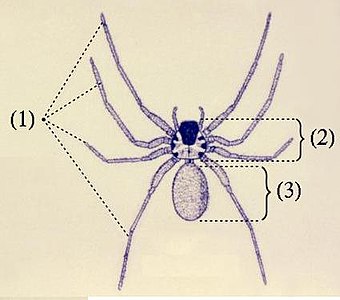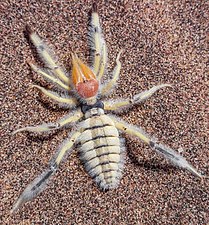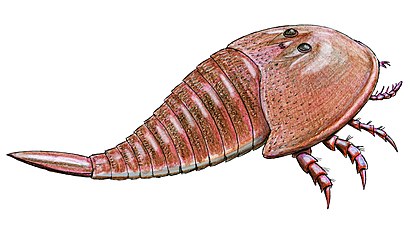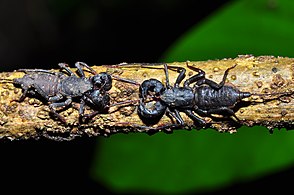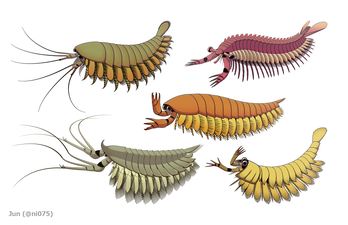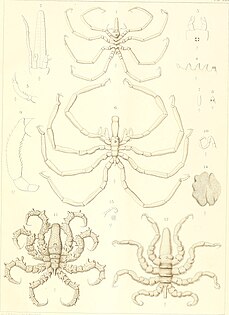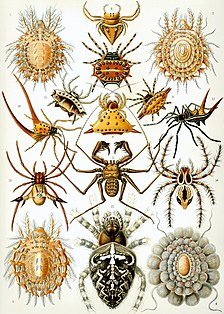「鋏角類」の版間の差分
小節区分 |
大幅追記|小節追加|内容調整|地質時代|画像|出典 タグ: サイズの大幅な増減 |
||
| 1行目: | 1行目: | ||
{{参照方法|date=2013年6月21日 (金) 23:34 (UTC)}} |
{{参照方法|date=2013年6月21日 (金) 23:34 (UTC)}} |
||
{{生物分類表 |
{{生物分類表 |
||
|fossil_range = {{Fossil range|earliest=525|505|0|ref=<ref name=":1"/>}} |
|||
|地質時代 = [[カンブリア紀]] |
|||
|地質時代2 = [[現世 (地球科学)|現世]] |
|||
|名称 = 鋏角類 |
|名称 = 鋏角類 |
||
|色 = 動物界 |
|色 = 動物界 |
||
|画像 = [[File:Chelicerata Collage.png|260px]] |
|画像 = [[File:Chelicerata Collage.png|260px]] |
||
|画像キャプション = 様々な鋏角類<br>左上:[[ウミグモ]]の1種([[ウミグモ綱]][[皆脚目]])<br>右上:[[ |
|画像キャプション = 様々な鋏角類<br>左上:[[ウミグモ]]の1種([[ウミグモ綱]][[皆脚目]])<br>右上:[[:en:Pentecopterus|ペンテコプテルス]]([[節口綱]][[ウミサソリ目]])<br>左下:[[アメリカカブトガニ]]([[節口綱]][[カブトガニ目]])<br>右下:[[トゲグモ]]の1種([[クモガタ綱]][[クモ目]]) |
||
|界 = [[動物]]界 [[:en:Animal|Animalia]] |
|界 = [[動物]]界 [[:en:Animal|Animalia]] |
||
|門 = [[節足動物]]門 [[:en:Arthropod|Arthropoda]] |
|門 = [[節足動物]]門 [[:en:Arthropod|Arthropoda]] |
||
| 11行目: | 14行目: | ||
|英名 = Chelicerate |
|英名 = Chelicerate |
||
|下位分類 = |
|下位分類 = |
||
* [[ウミグモ綱]] [[ |
* [[ウミグモ綱]] [[:en:Pycnogonida|Pycnogonida]] |
||
* [[真鋏角類]] [[:en:Euchelicerata|Euchelicerata]] |
* [[真鋏角類]] [[:en:Euchelicerata|Euchelicerata]] |
||
** [[節口綱]] Merostomata([[側系統群]]) |
** [[節口綱]] Merostomata([[側系統群]]) |
||
** [[クモガタ綱]] [[ |
** [[クモガタ綱]] [[:en:Arachnida|Arachnida]] |
||
}} |
}} |
||
'''鋏角類'''(きょうかくるい、[[:en:Chelicerate|'''Chelicerate''']])は、[[節足動物]]を大まかに分ける分類群のひとつである。通常では'''鋏角亜門'''('''[[w:Chelicerata|Chelicerata]]''')の総称とされ、[[クモ]]・[[サソリ]]・[[ダニ]]などの[[クモガタ類]]、および[[カブトガニ類|カブトガニ]]・[[ウミサソリ]]・[[ウミグモ]]などを含む。[[鋏角]]をもつことを特徴とする<ref name="Dunlop2017" />。 |
'''鋏角類'''(きょうかくるい、[[:en:Chelicerate|'''Chelicerate''']])は、[[節足動物]]を大まかに分ける[[分類群]]のひとつである。通常では'''鋏角亜門'''('''[[w:Chelicerata|Chelicerata]]''')の総称とされ、[[クモ]]・[[サソリ]]・[[ダニ]]などの[[クモガタ類]]、および[[カブトガニ類|カブトガニ]]・[[ウミサソリ]]・[[ウミグモ]]などを含む。[[鋏角]]をもつことを特徴とする<ref name="Dunlop2017" />。 |
||
11万種以上が知られ<ref name=":10" />、現生節足動物の4つの[[亜門]]の中では2番目に種を富んだ分類群である。系統関係については、[[多足類]]・[[甲殻類]]・[[六脚類]]という3つの亜門を含んだ[[大顎類]]と姉妹群になり、現生節足動物を大きく分けた2つの系統群の一角になる<ref name=":2" />。 |
|||
==概要== |
|||
==形態== |
|||
[[ファイル:1911 Britannica-Arachnida-Garypus litoralis.png|サムネイル|180px|[[カニムシ]]の構造<br>I:[[鋏角]]、II:[[触肢]]、III-VI:歩脚、1-11:後体]] |
|||
<gallery mode="packed" heights="200"> |
<gallery mode="packed" heights="200"> |
||
ファイル:Eurypterus anatomy.png|[[ウミサソリ]]の構造 |
ファイル:Eurypterus anatomy.png|[[ウミサソリ]]の構造 |
||
ファイル:Scorpion Tagged (PSF).png|[[サソリ]]の構造<br |
ファイル:Scorpion Tagged (PSF).png|[[サソリ]]の構造<br>各項説明:<ref group="注釈">O:[[単眼]]<br>緑:前体([[頭胸部]])<br>黄(1-7):中体(前腹部)<br>ピンク(M1-M5):終体(後腹部)<br>T:[[尾節]]<br>A:[[肛門]]<br>C:[[鋏角]]<br>P:[[触肢]]<br>Co・Fe・Ti・Ta:歩脚</ref> |
||
ファイル:Archindae characters.jpg|[[クモ]]の構造<br |
ファイル:Archindae characters.jpg|[[クモ]]の構造<br>(1):歩脚、(2):前体、(3):後体 |
||
</gallery> |
</gallery> |
||
鋏角類に含まれる[[節足動物]]は以下のような基本的体制の違いによって、それ以外の[[節足動物]]([[大顎類]]・[[三葉虫]]類など)から区別できる。 |
鋏角類に含まれる[[節足動物]]は以下のような基本的体制の違いによって、それ以外の[[節足動物]]([[大顎類]]・[[三葉虫]]類など)から区別できる。 |
||
#一部の例外を除き<ref group="注釈">[[ウミグモ]]の体は頭部・胴部・腹部の3部として区別されることが多い。詳細は[[ウミグモ#体節の構成|該当項目]]を参照。</ref>、体は'''前体'''([[ |
#一部の例外を除き<ref group="注釈">[[ウミグモ]]の体は頭部・胴部・腹部の3部として区別されることが多い。詳細は[[ウミグモ#体節の構成|該当項目]]を参照。</ref>、体は'''前体'''([[:en:Prosoma|Prosoma]]、[[頭胸部]])と'''後体'''([[:en:Opisthosoma|Opisthosoma]]、[[腹部]])の2部のみからなる。 |
||
#第1対の付属肢は'''[[鋏角]]'''である<ref name="Dunlop2017" />。([[大顎類]]と[[三葉虫]]の場合は[[触角]]である) |
#第1対の付属肢は'''[[鋏角]]'''である<ref name="Dunlop2017" />。([[大顎類]]と[[三葉虫]]の場合は[[触角]]である) |
||
#前部の合体節の[[付属肢]]はほとんどが歩脚 |
#鋏角を除き、前部の合体節の[[付属肢]]はほとんどが歩脚型である。([[大顎類]]の場合はほとんどが[[触角]]と顎をなす) |
||
#[[触角]]と真の顎として独立した[[付属肢]]は存在しない。(その機能らしい別の付属肢/部位をもつ例のみが存在する<ref name=":0" group="注釈" />) |
#[[触角]]と真の顎として独立した[[付属肢]]は存在しない。(その機能らしい別の付属肢/部位をもつ例のみが存在する<ref name=":0" group="注釈" />) |
||
===前体=== |
===前体=== |
||
{{see also|鋏角|触肢}} |
{{see also|鋏角|触肢}} |
||
[[ファイル:1911 Britannica-Arachnida-Limulus polyphemus6.png |
[[ファイル:Chelicerae.svg|サムネイル|[[クモ]](A)、[[ヒヨケムシ]](B)、および[[コヨリムシ]](C)の[[鋏角]]。]] |
||
[[ファイル:1911 Britannica-Arachnida-Limulus polyphemus6.png|サムネイル|右|[[サソリ]](左列)と[[アメリカカブトガニ]](右列)の前体付属肢比較図<br>I:[[鋏角]]<br>II:[[触肢]]<br>III-VI:歩脚]] |
|||
<gallery mode="packed" heights=" |
<gallery mode="packed" heights="200"> |
||
ファイル:Naturalis Biodiversity Center - RMNH.ART.29 - Tachypleus tridentatus - Kawahara Keiga - 1823 - 1829 - Siebold Collection - pencil drawing - water colour.jpeg|[[カブトガニ]]の腹側。幅広い背甲に覆われた1対の短い[[鋏角]]と5対の歩脚型付属肢がある。 |
ファイル:Naturalis Biodiversity Center - RMNH.ART.29 - Tachypleus tridentatus - Kawahara Keiga - 1823 - 1829 - Siebold Collection - pencil drawing - water colour.jpeg|[[カブトガニ]]の腹側。幅広い背甲に覆われた1対の短い[[鋏角]]と5対の歩脚型付属肢がある。 |
||
ファイル:Skorpion fg02.jpg|[[はさみ (動物)|はさみ]]型に特殊化し |
ファイル:Skorpion fg02.jpg|[[サソリ]]。[[触肢]]は[[はさみ (動物)|はさみ]]型に特殊化し、口元に短い[[鋏角]]があり、中眼と単眼はそれぞれ背甲の背側と前両側にある。 |
||
ファイル:Kaldari Phidippus audax 01.jpg|[[ハエトリグモ]]。背甲は単眼を備え、その下は金属光沢をもった[[鋏角]]、短い[[触肢]]と4対の発達 |
ファイル:Kaldari Phidippus audax 01.jpg|[[ハエトリグモ]]。背甲は側眼と中眼に由来の単眼を備え、その下は金属光沢をもった[[鋏角]]、短い[[触肢]]と4対の発達した歩脚をもつ。 |
||
</gallery> |
</gallery> |
||
前体([[ |
前体([[:en:Prosoma|Prosoma]])は[[先節]]と直後6つの体節からなり、それに応じて計6対の[[付属肢]]([[関節肢]])をもつ。通常は前体全ての体節が癒合して背面が1枚の[[背甲]]に覆われるが、第5と第6体節が独自に分節した例も存在する<ref group="注釈">[[ヒヨケムシ]]・[[ヤイトムシ]]・[[コヨリムシ]]・[[ザトウムシ]](痕跡的)・[[ウミグモ]]など。</ref><ref name="Dunlop2017" />。 |
||
第1体節は本群の特徴である1対の'''[[鋏角]]'''([[:en:chelicerae|chelicerae]]、[[ウミグモ]]の場合は'''鋏肢''' cheliforesという)をもつ。通常は目立てない[[はさみ (動物)|鋏]]型の付属肢であるが、分類群によっては巨大化したり<ref group="注釈">[[ヒヨケムシ]]・[[プテリゴトゥス科]]の[[ウミサソリ]]・一部の[[クモ]]([[トタテグモ下目]]・[[アシナガグモ科]]のオス・[[アリグモ]]属のオスなど)。</ref>ナイフ型<ref group="注釈">[[四肺類]]([[クモ]]・[[コスリイムシ目|コスリイムシ]]・[[ウデムシ]]・[[サソリモドキ]]・[[ヤイトムシ]]など)。</ref>になったりする場合もある。次の第2-6体節は、7節前後の肢節に分かれる5対の歩脚型付属肢があり、そのうち最初の一対は'''[[触肢]]'''([[:en:pedipalp|pedipalps]])としてやや異なった構造へ特殊化した場合がある<ref name="Dunlop2017">{{Cite journal|last=A.|first=Dunlop, Jason|last2=C.|first2=Lamsdell, James|title=Segmentation and tagmosis in Chelicerata|url=https://www.academia.edu/28212892/Segmentation_and_tagmosis_in_Chelicerata|journal=Arthropod Structure & Development|volume=46|issue=3|language=en|issn=1467-8039}}</ref>。感覚や摂食の機能を補助する付属肢(およびその一部の構造体)をもつ例があるものの、[[大顎類]]に見当たる触角と真の顎は存在しない<ref group="注釈" name=":0">摂食用の[[鋏角]](第1体節由来、大顎類の第3-5体節由来の顎に[[相似 (生物学)|相似]])、<br />[[カブトガニ類]]と[[ウミサソリ]]類の顎基(歩脚の基節の突起物であり、独立の付属肢ではない)、<br />[[ウデムシ]]・[[サソリモドキ]]・[[ヤイトムシ]]の感覚用の第1脚(第3体節由来、[[大顎類]]の第1-2体節由来の触角に[[相似 (生物学)|相似]])、<br />などが挙げられる。</ref>。[[口]]は鋏角と触肢の間に開き、目立てない[[上唇 (節足動物)|上唇]]に覆われるが、[[ウミグモ]]類の場合では上唇の代わりに発達した円筒状の吻をもち、口はその先端に開く<ref name="Dunlop2017" />。 |
|||
この部分は「[[頭胸部]]」([[w:Cephathorax|cephathorax]])とも呼ばれていたが、鋏角類の前体は1つの合体節(tagma)で、[[甲殻類]]に見当たる頭部と胸部という2つの合体節の癒合を通じて由来する頭胸部とは異なっており、そこに含まれた体節(第1-6体節)はほとんどが[[大顎類]]の頭部に[[相同]]である(第1-5体節)。従って、[[大顎類]]における顎として特殊化した付属肢は、鋏角類の場合ではその殆どが歩脚として用いられる([[鋏角類#系統関係|後述の対応関係]]も参照)<ref>{{Cite journal|last=Sharma|first=Prashant|last2=Gupta|first2=Tripti|last3=E Schwager|first3=Evelyn|last4=Wheeler|first4=W.C.|last5=Extavour|first5=Cassandra|date=2014-01-09|title=Subdivision of arthropod cap-n-collar expression domains is restricted to Mandibulata|url=https://www.researchgate.net/publication/259650500_Subdivision_of_arthropod_cap-n-collar_expression_domains_is_restricted_to_Mandibulata?_sg=wpK3nhl9qI4T1BMnqlWrGWEsA0JZdl1t1038YMjAfR1cghbFtKzkMyxhWbED0xoMyWyKYLJ9bg|journal=EvoDevo|volume=5|pages=3|doi=10.1186/2041-9139-5-3}}</ref>。節足動物全般の頭部構成に因む議論、特に他の節足動物の頭部と比較する場合、鋏角類の前体は常に「頭部」扱いとされる<ref>{{Cite journal|date=2017-05-01|title=Origin and evolution of the panarthropod head – A palaeobiological and developmental perspective|url=https://www.sciencedirect.com/science/article/pii/S1467803916301669|journal=Arthropod Structure & Development|volume=46|issue=3|pages=354–379|language=en|doi=10.1016/j.asd.2016.10.011|issn=1467-8039}}</ref><ref>{{Cite journal|date=2003-12-01|title=Larval development and morphogenesis of the sea spider Pycnogonum litorale (Ström, 1762) and the tagmosis of the body of Pantopoda|url=https://www.sciencedirect.com/science/article/pii/S1467803903001154|journal=Arthropod Structure & Development|volume=32|issue=4|pages=349–383|language=en|doi=10.1016/j.asd.2003.09.004|issn=1467-8039}}</ref>。 |
|||
この部分は「[[頭胸部]]」([[:en:Cephathorax|cephathorax]])とも呼ばれていたが、鋏角類の前体は1つの合体節(tagma)で、[[甲殻類]]に見当たる頭部と胸部という2つの合体節の癒合を通じて由来する頭胸部とは異なり、そこに含まれた体節(第1-6体節)はほとんどが[[大顎類]]の頭部に[[相同]]である(第1-5体節)。従って、[[大顎類]]において顎に特殊化した付属肢は、鋏角類の場合ではそのほとんどが歩脚として用いられる([[鋏角類#系統関係|後述の対応関係]]も参照)<ref>{{Cite journal|last=Sharma|first=Prashant|last2=Gupta|first2=Tripti|last3=E Schwager|first3=Evelyn|last4=Wheeler|first4=W.C.|last5=Extavour|first5=Cassandra|date=2014-01-09|title=Subdivision of arthropod cap-n-collar expression domains is restricted to Mandibulata|url=https://www.researchgate.net/publication/259650500_Subdivision_of_arthropod_cap-n-collar_expression_domains_is_restricted_to_Mandibulata?_sg=wpK3nhl9qI4T1BMnqlWrGWEsA0JZdl1t1038YMjAfR1cghbFtKzkMyxhWbED0xoMyWyKYLJ9bg|journal=EvoDevo|volume=5|pages=3|doi=10.1186/2041-9139-5-3}}</ref>。節足動物全般の頭部構成に因む議論、特に他の節足動物の頭部と比較する場合、鋏角類の前体は常に「頭部」扱いとされる<ref name=":13">{{Cite journal|date=2017-05-01|title=Origin and evolution of the panarthropod head – A palaeobiological and developmental perspective|url=https://www.sciencedirect.com/science/article/pii/S1467803916301669|journal=Arthropod Structure & Development|volume=46|issue=3|pages=354–379|language=en|doi=10.1016/j.asd.2016.10.011|issn=1467-8039}}</ref><ref>{{Cite journal|date=2003-12-01|title=Larval development and morphogenesis of the sea spider Pycnogonum litorale (Ström, 1762) and the tagmosis of the body of Pantopoda|url=https://www.sciencedirect.com/science/article/pii/S1467803903001154|journal=Arthropod Structure & Development|volume=32|issue=4|pages=349–383|language=en|doi=10.1016/j.asd.2003.09.004|issn=1467-8039}}</ref>。 |
|||
[[ウミグモ]]類は集約した4つの単眼のみをち、それ以外の鋏角類では原則としてそれぞれ背甲の中心と左右に備わる中眼(median eye)と側眼(lateral eye、単に単眼ともいう)をもつ。[[カブトガニ類]]・[[ウミサソリ]]類・原始的な[[サソリ]]類の側眼は[[複眼]]であるが、現生の[[クモガタ類]]はそれが退化し、複眼由来の数対以下の単眼となる<ref name=":9">{{Cite journal|last=Lehmann|first=Tobias|last2=Melzer|first2=Roland R.|date=2018-12|title=Also looking like Limulus? – retinula axons and visual neuropils of Amblypygi (whip spiders)|url=https://frontiersinzoology.biomedcentral.com/articles/10.1186/s12983-018-0293-6|journal=Frontiers in Zoology|volume=15|issue=1|pages=52|language=en|doi=10.1186/s12983-018-0293-6|issn=1742-9994|pmid=30574172|pmc=PMC6299927}}</ref>。なお、全ての眼を退化消失した鋏角類もある。 |
|||
===後体=== |
===後体=== |
||
[[ファイル:Origin of Vertebrates Fig 058.png|220px|サムネイル|右|[[カブトガニ類]]の後体断面図と鰓脚の構造]] |
[[ファイル:Origin of Vertebrates Fig 058.png|220px|サムネイル|右|[[カブトガニ類]]の後体断面図と鰓脚の構造]] |
||
<gallery mode="packed" heights="150"> |
<gallery mode="packed" heights="150"> |
||
ファイル:The Eurypterida of New York figure 19.jpg|[[ウミサソリ]]の生殖肢 |
|||
File:1911 Britannica-Arachnida-Thelyphonus assamensis.png|[[サソリモドキ]]の書肺(''l'') |
|||
ファイル:1911 Britannica-Arachnida-Thelyphonus assamensis.png|[[サソリモドキ]]の書肺(''l'') |
|||
ファイル:Australian garden orb weaver spider spinneret.jpg|糸を出す[[クモ]]の糸疣 |
ファイル:Australian garden orb weaver spider spinneret.jpg|糸を出す[[クモ]]の糸疣 |
||
ファイル:Skorpion fg03.jpg|[[サソリ]]の櫛状板(赤印先、黄色の部分) |
ファイル:Skorpion fg03.jpg|[[サソリ]]の櫛状板(赤印先、黄色の部分) |
||
</gallery> |
</gallery> |
||
「[[腹部]]」とも呼ばれる。体の第7体節から始め、最多は13節からなる(第19体節まで及ぶ)<ref name=Dunlop2017/>。[[サソリ]]や[[ウミサソリ]]のように、後体は更に'''中体'''([[ |
「[[腹部]]」(abdomen)とも呼ばれる。体の第7体節から始め、最多は13節からなる(第19体節まで及ぶ)<ref name=Dunlop2017/>。[[サソリ]]や[[ウミサソリ]]のように、後体は更に'''中体'''([[:en:Mesosoma|mesosoma]]、前腹部)と'''終体'''([[:en:Metasoma|metasoma]]、後腹部)として区別でき、または後端の3節が細短い尾部([[w:pygidium|pygidium]])となる分類群もある<ref group="注釈">[[ウデムシ]]・[[サソリモドキ]]・[[ヤイトムシ]]・[[クツコムシ]]・[[コヨリムシ]]・一部の基盤的な[[カブトガニ類]]([[w:Synziphosurine|Synziphosurine]])</ref>。最終体節の[[肛門]]の直後に[[尾節]]([[w:Telson|telson]])をもつ分類群も少なからずにあり、その形は分類群によって剣状・へら状・鞭状など様々である<ref group="注釈">剣状:[[カブトガニ類]]、ほとんどの[[ウミサソリ]]類、[[パレオイソプス]]([[ウミグモ]])<br>へら状:[[プテリゴトゥス上科]]の[[ウミサソリ]]類<br>鞭状:[[コヨリムシ]]、[[サソリモドキ]]、''[[:en:Flagellopantopus|Flagellopantopus]]''([[ウミグモ]])</ref><ref name="Dunlop2017" />。 |
||
現生の鋏角類に限れば、後体の[[付属肢]]はほとんどが退化的であり、あっても歩脚状から飛び抜けた形態をもつ。[[カブトガニ類]]などの[[節口綱|節口類]]の後体付属肢は鰭状の蓋板(operculum)であり、[[クモ綱|クモガタ類]]の書肺とそれを覆う板状構造・[[クモ]]の糸疣・[[サソリ]]の櫛状板・[[ウミサソリ]]、[[ウデムシ]]と[[サソリモドキ]]の生殖肢などの器官は、著しく特殊化した後体付属肢であると考えられる<ref name=Dunlop2017/>。 |
現生の鋏角類に限れば、後体の[[付属肢]]はほとんどが退化的であり、あっても歩脚状から飛び抜けた形態をもつ。[[カブトガニ類]]などの[[節口綱|節口類]]の後体付属肢は鰭状の蓋板(operculum)であり、[[クモ綱|クモガタ類]]の書肺とそれを覆う板状構造・[[クモ]]の糸疣・[[サソリ]]の櫛状板・[[ウミサソリ]]、[[ウデムシ]]と[[サソリモドキ]]の生殖肢などの器官は、著しく特殊化した後体付属肢であると考えられる<ref name=Dunlop2017/><ref>{{Cite journal|last=Di|first=Zhiyong|last2=Edgecombe|first2=Gregory D.|last3=Sharma|first3=Prashant P.|date=2018-05-21|title=Homeosis in a scorpion supports a telopodal origin of pectines and components of the book lungs|url=https://doi.org/10.1186/s12862-018-1188-z|journal=BMC Evolutionary Biology|volume=18|issue=1|pages=73|doi=10.1186/s12862-018-1188-z|issn=1471-2148|pmid=29783957|pmc=PMC5963125}}</ref>。 |
||
特に注目されるのは、その第1節(第7体節)である。[[クモガタ類]]の場合、この体節は付属肢を欠き、一部の群ではくびれて腹柄となる。しかし[[カブトガニ類]]の場合、この体節は前体へ癒合し、1対の[[唇様肢]](chilaria)という小さな付属肢を備える<ref name="Dunlop2017" /><ref name=":0" />。[[ウミサソリ]]類もそれに似通 |
特に注目されるのは、その第1節(第7体節)である。[[クモガタ類]]の場合、この体節は付属肢を欠き、一部の群ではくびれて腹柄となる。しかし[[カブトガニ類]]の場合、この体節は前体へ癒合し、1対の[[唇様肢]](chilaria)という小さな付属肢を備える<ref name="Dunlop2017" /><ref name=":0" />。[[ウミサソリ]]類もそれに似通い、癒合した付属肢と思われる1枚の「metastoma」を持っていた<ref name="Dunlop2017" />。[[ウミグモ]]と[[ウェインベルギナ]]は更なる極端な例であり、この体節は前体と同形の歩脚をもっていた<ref name="Dunlop2017" />。特に前者は、この第7体節を胴部の一部と扱うことが一般的である<ref name="Dunlop2017" /><ref>{{Cite journal|date=2003-12-01|title=Larval development and morphogenesis of the sea spider Pycnogonum litorale (Ström, 1762) and the tagmosis of the body of Pantopoda|url=https://www.sciencedirect.com/science/article/pii/S1467803903001154|journal=Arthropod Structure & Development|volume=32|issue=4|pages=349–383|language=en|doi=10.1016/j.asd.2003.09.004|issn=1467-8039}}</ref>。これによって、第7体節の多くの形質は前体的であり、前体の一部と扱うべきではないかという提唱もある<ref name="Dunlop2017" /><ref name=":0" />。 |
||
生殖孔(gonopore)はウミグモ類では各脚の基部に開いている<ref name=":6" />が、それ以外の鋏角類(真鋏角類)では後体第2節の腹側に開き、生殖口蓋(genital operculum)に覆われる<ref name="Dunlop2017" />。 |
|||
=== 神経系 === |
|||
[[ファイル:Phrynus.cns.boerner.1904.png|サムネイル|[[ウデムシ]]の中枢神経系。br:脳/食道上神経塊、ce:後体の神経、le:側眼、me:中眼、nch:鋏角の神経、np1-np4:第1-4脚の神経、npd:触肢の神経、seg:食道下神経塊]] |
|||
他の[[節足動物]]と同様、鋏角類は[[はしご形神経系]]をもつ。[[脳]](brain もしくは syncerebrum<ref name=":7">{{Cite journal|last=Smarandache-Wellmann|first=Carmen Ramona|date=10 24, 2016|title=Arthropod neurons and nervous system|url=https://www.ncbi.nlm.nih.gov/pubmed/27780069|journal=Current biology: CB|volume=26|issue=20|pages=R960–R965|doi=10.1016/j.cub.2016.07.063|issn=1879-0445|pmid=27780069}}</ref>)に含まれる[[神経節]]と付属肢の対応関係はかつて議論があったが([[鋏角類#体節と付属肢の対応関係|後述参照]])、2010年代以降では[[先節]]の神経節を前大脳(protocerebrum)、第1体節/[[鋏角]]の神経節を中大脳(deutocerebrum)、第2体節/[[触肢]]の神経節を後大脳(tritocerebrum)、それ以降の体節/付属肢の神経節を腹神経索(ventral nerve cord)と扱うのが一般的である<ref name=":13" />。[[ウミグモ]]類の脚の神経節ははっきりとしたはしご形を残るが、[[カブトガニ類]]と[[クモガタ類]]の場合、脳神経節と脚の神経節は著しく癒合して脳と腹神経索の境目がほぼなくなり、すなわち前体の全ての神経節が「synganglion」という1つの集中部になっている<ref name=":7" />。食道はその中心([[神経解剖学]]的には中大脳の間<ref name=":8" />)を貫通しており、これに基づいてsynganglionを前後で食道上神経塊(supraesophageal ganglion)と食道下神経塊(subesophageal ganglion)として区別される場合もある<ref>{{Cite journal|last=Park|first=Yong-Ki|last2=Gu|first2=Hye-Yoon|last3=Kwon|first3=Hyun-Jung|last4=Kim|first4=Hoon|last5=Moon|first5=Myung-Jin|date=2018-03-30|title=Fine Structure of the Neuroganglia in the Central Nervous System of the Harvestman Leiobunum japonicum (Arachnida: Opiliones)|url=http://www.appmicro.org/journal/view.html?doi=10.9729/AM.2018.48.1.17|journal=Applied Microscopy|volume=48|issue=1|pages=17–26|language=en|doi=10.9729/AM.2018.48.1.17|issn=2287-5123}}</ref>。後体の神経節の場合、カブトガニ類と[[サソリ]]類ははしご形のままであるが、他のクモガタ類は前体へと集約される<ref name=":7" />。側眼の[[視神経]]が3つの神経網をもつ[[大顎類]]とは異なり、現生鋏角類の側眼の視神経は1つの神経網のみをもつ<ref name=":9" />。 |
|||
{{-}} |
|||
== 生態 == |
|||
=== 生息地 === |
|||
[[ファイル:Spiders Diversity.jpg|サムネイル|陸上で多様化した[[クモ]]。]] |
|||
<gallery mode="packed" heights="150"> |
|||
ファイル:Metasolpuga picta00.jpg|[[ヒヨケムシ]]は主に[[砂漠]]に生息している。 |
|||
File:Водяной клещ.jpg|水生の[[クモガタ類]]である[[ミズダニ]]。 |
|||
ファイル:Expl0892 - Flickr - NOAA Photo Library.jpg|深さ1570mの[[深海]]から発見された2匹の[[オオウミグモ]]。 |
|||
ファイル:Hibbertopterus scouleri.jpg|[[ヒベルトプテルス]]は陸上で活動できたと考えられる[[ウミサソリ]]の1つ。 |
|||
</gallery> |
|||
鋏角類の中で[[クモガタ類]]はほとんどが[[陸]]生で、様々な陸上[[生態系]]に進出しており、[[砂漠]]・[[極地]]・高山など極端な環境に生息する種類もある<ref name=":14">{{Cite journal|last=Howard|first=Richard J.|last2=Edgecombe|first2=Gregory D.|last3=Legg|first3=David A.|last4=Pisani|first4=Davide|last5=Lozano-Fernandez|first5=Jesus|date=2019-03-01|title=Exploring the evolution and terrestrialization of scorpions (Arachnida: Scorpiones) with rocks and clocks|url=https://doi.org/10.1007/s13127-019-00390-7|journal=Organisms Diversity & Evolution|volume=19|issue=1|pages=71–86|language=en|doi=10.1007/s13127-019-00390-7|issn=1618-1077}}</ref>。水中生態系の場合、クモガタ類には[[ミズダニ]]や[[ミズグモ]]など陸から二次的に水生化したものが知られ<ref name=":14" />、[[カブトガニ類]]と[[ウミグモ]]類は現生群ではすべてが海棲である。しかし化石群まで範囲を広げると、カブトガニ類と[[ウミサソリ]]類はいずれも海棲・陸水性と考えられる種類が挙げられており、特にウミサソリ類に関しては、少なくとも短時間の陸上活動をできたと思われる種類もある<ref>{{Cite journal|last=Whyte|first=Martin A.|date=2005-12|title=A gigantic fossil arthropod trackway|url=https://www.nature.com/articles/438576a|journal=Nature|volume=438|issue=7068|pages=576–576|language=en|doi=10.1038/438576a|issn=1476-4687}}</ref><ref>{{Cite journal|last=Tetlie|first=O. Erik|date=2007-09-03|title=Distribution and dispersal history of Eurypterida (Chelicerata)|url=http://www.sciencedirect.com/science/article/pii/S003101820700291X|journal=Palaeogeography, Palaeoclimatology, Palaeoecology|volume=252|issue=3|pages=557–574|language=en|doi=10.1016/j.palaeo.2007.05.011|issn=0031-0182}}</ref>。 |
|||
=== 食性 === |
|||
[[ファイル:Argiope amoena captured Graptopsaltria nigrofuscata.JPG|サムネイル|[[アブラゼミ]]を捕食する[[コガネグモ]]。]] |
|||
<gallery mode="packed" heights="150"> |
|||
ファイル:Bryobia praetiosa Koch.jpg|草食性の[[ハダニ]]。 |
|||
ファイル:Opiliones, Eupnoi, F. Sclerosomatidae, Leiobunum vittatum group, male with prey (3679665965).jpg|[[ハエ]]を食べている[[ザトウムシ]]。 |
|||
ファイル:Nymphon-leptocheles.jpg|[[ヒドロ虫]]([[刺胞動物]])を摂食している[[ウミグモ]]。 |
|||
</gallery> |
|||
鋏角類は一般に[[捕食者]]の[[ニッチ]](生態的地位)を占めるが、幾つかの例外も挙げられる。[[クモガタ類]]は多くが[[昆虫]]などの小型[[節足動物]]を捕食する[[肉食]]動物であるが、その中で[[ダニ]]類は例外的で肉食性・[[草食]]性・[[腐植]]食性・[[寄生]]性・[[吸血]]性まで多岐にわたり<ref>{{Citation|title=なぜダニ類はクモガタ類の中で最も種数が多いのか?|url=https://doi.org/10.19004/taxa.44.0_4|publisher=日本動物分類学会|date=2018|accessdate=2020-04-28|doi=10.19004/taxa.44.0_4|language=ja|first=智之|last=島野}}</ref>、[[ザトウムシ]]類は[[雑食]]性や[[腐肉食]]性の種類によって知られる。捕食者として代表的である[[クモ]]類の中でも吸蜜行動が見られ<ref>{{Cite journal|last=Jackson|first=Robert R.|last2=Pollard|first2=Simon D.|last3=Nelson|first3=Ximena J.|last4=Edwards|first4=G. B.|last5=Barrion|first5=Alberto T.|title=Jumping spiders (Araneae: Salticidae) that feed on nectar|url=https://www.academia.edu/19566526/Jumping_spiders_Araneae_Salticidae_that_feed_on_nectar|journal=Journal of Zoology|volume=255|issue=1|pages=25–29|language=en|issn=0952-8369}}</ref><ref>{{Cite web|title=蜜吸うクモ 機関紙で論文発表 名張の岡田さん {{!}} 【伊賀タウン情報 YOU】|url=https://www.iga-younet.co.jp/2019/08/05/17495/|date=2019-08-04|accessdate=2020-04-27|language=ja|last=伊賀タウン情報YOU編集部}}</ref>、植物成分を主食とする[[バギーラ・キプリンギ|1種]]も報告られる<ref>{{Cite journal|last=Meehan|first=Christopher J.|last2=Olson|first2=Eric J.|last3=Reudink|first3=Matthew W.|last4=Kyser|first4=T. Kurt|last5=Curry|first5=Robert L.|date=2009-10-13|title=Herbivory in a spider through exploitation of an ant–plant mutualism|url=https://www.cell.com/current-biology/abstract/S0960-9822(09)01626-1|journal=Current Biology|volume=19|issue=19|pages=R892–R893|language=English|doi=10.1016/j.cub.2009.08.049|issn=0960-9822|pmid=19825348}}</ref>。絶滅群の[[ウミサソリ]]類は多くが活発な捕食者であったと考えられ、現生の[[カブトガニ類]]は肉食性に偏る雑食性である<ref>{{Cite journal|last=Botton|first=M. L.|date=1984-08-01|title=Diet and food preferences of the adult horseshoe crab Limulus polyphemus in Delaware Bay, New Jersey, USA|url=https://doi.org/10.1007/BF00393118|journal=Marine Biology|volume=81|issue=2|pages=199–207|language=en|doi=10.1007/BF00393118|issn=1432-1793}}</ref>。[[ウミグモ]]類の食性については研究が進んでいないが、主に[[刺胞動物]]など柔らかい[[固着性|固着生物]]の体内組織を摂ることが知られ、これは文献によって捕食性もしくは寄生性と扱われる<ref name=":5">{{Cite journal|last=Dietz|first=Lars|last2=Dömel|first2=Jana S.|last3=Leese|first3=Florian|last4=Lehmann|first4=Tobias|last5=Melzer|first5=Roland R.|date=2018-03-15|title=Feeding ecology in sea spiders (Arthropoda: Pycnogonida): what do we know?|url=https://doi.org/10.1186/s12983-018-0250-4|journal=Frontiers in Zoology|volume=15|issue=1|pages=7|doi=10.1186/s12983-018-0250-4|issn=1742-9994|pmid=29568315|pmc=PMC5856303}}</ref>。 |
|||
[[ファイル:The Eurypterida of New York figure 5.jpg|サムネイル|[[カブトガニ類]]の前体の横断面図。脚の基節に嚙み合わせた[[顎基]]をもつ。]] |
|||
多くの場合、鋏角類の[[鋏角]]は口器として機能する主な部分であり、餌を把握・切断・粉砕するのに用いられる。クモ類の場合、牙のような鋏角は[[毒腺]]をもち、毒を獲物に注入する機能を備わっている<ref name="Dunlop2017" />。鋏角以外の前体付属肢([[触肢]]や脚)の基部が摂食を補助する構造をもつ場合もあり、例えばクモ類の下顎(maxilla、触肢の基部に備わる)・ザトウムシ類の顎葉(coxapophyses、触肢と第1脚の基部に備わる)<ref>{{Cite journal|last=Shultz|first=Jeffrey W.|date=2000-04-01|title=Skeletomuscular anatomy of the harvestman Leiobunum aldrichi (Weed, 1893) (Arachnida: Opiliones: Palpatores) and its evolutionary significance|url=https://academic.oup.com/zoolinnean/article/128/4/401/2630808|journal=Zoological Journal of the Linnean Society|volume=128|issue=4|pages=401–438|language=en|doi=10.1111/j.1096-3642.2000.tb01522.x|issn=0024-4082}}</ref>・カブトガニ類とウミサソリ類の[[顎基]](gnathobase、触肢と全ての脚の基部に備わる)などが挙げられる。ウミグモ類は突き出した吻で直接に餌を摂るが、発達した鋏肢と触肢をもつ種類ではこれらの付属肢も摂食行動に参加している<ref name=":5" />。 |
|||
多くのクモガタ類は固形物の餌を直接に摂食せず、代わりに[[消化液]]で餌を体外消化し、軟組織を液体状に分解してから口へと飲み込むが、ザトウムシ類は例外的に固形物を直接に摂食できる。現生のカブトガニ類は発達した[[前胃]]で固形物の餌を細かく砕き、食べられない物をここから噴き返すこともできる<ref>{{Cite web|title=Atlantic Horseshoe Crab|url=http://tacbio.weebly.com/atlantic-horseshoe-crab.html|website=Digestive systems|accessdate=2020-04-27}}</ref>。 |
|||
=== 繫殖と発育 === |
|||
[[ファイル:Multi-Modal-Courtship-in-the-Peacock-Spider-Maratus-volans-(O.P.-Cambridge-1874)-pone.0025390.s001.ogv|サムネイル|[[ハエトリグモ]]の求愛ダンス。]] |
|||
[[ファイル:Limulus polyphemus1.jpg|サムネイル|[[カブトガニ類|カブトガニ]]はオス(奥)がメス(手前)を包接する習性をもつ。]] |
|||
<gallery mode="packed" heights="130"> |
|||
File:Neriene radiata - 2013-07-04.webm|[[サラグモ科|サラグモ]]の交接。 |
|||
ファイル:Vinegaroons in courtship (Thelyphonus sp) (8390306848).jpg|求愛中の[[サソリモドキ]]。 |
|||
ファイル:Scorpion & Maternity.jpg|幼生を背負う[[サソリ]]。 |
|||
ファイル:Pantopoda male with embryos.jpg|抱卵中の[[ウミグモ]]。 |
|||
</gallery> |
|||
鋏角類の中で様々な[[繁殖行動]]が見られ、[[クモガタ類]]の中では特殊な求愛行動をもつ分類群もいくつか挙げられる。[[配偶子]]のやりとりとして、[[ザトウムシ]]類は交尾(雌雄生殖器の接続を通じて行う)、他のクモガタ類は交接(精包の受け渡しなど、交尾以外の方法で精子をメスの生殖孔に入り込む)、[[カブトガニ類]]と[[ウミグモ]]類は[[体外受精]]を通じて行う<ref name=":6">{{Cite journal|last=BAIN|author=|first=BONNIE A.|last2=GOVEDICH|first2=FREDRIC R.|year=|date=2004-12-01|title=Courtship and mating behavior in the Pycnogonida (Chelicerata: Class Pycnogonida): a summary|url=https://www.researchgate.net/publication/233026662_Courtship_and_mating_behavior_in_the_Pycnogonida_Chelicerata_Class_Pycnogonida_A_summary|journal=Invertebrate Reproduction & Development|volume=46|issue=1|page=|pages=63–79|doi=10.1080/07924259.2004.9652607|issn=0792-4259}}</ref>。原則として卵生だが、[[サソリ]]は卵胎生である。卵や幼生の世話をする保育行動は、クモガタ類とウミグモ類に普遍に見られる<ref name=":6" />。 |
|||
他の[[節足動物]]と同様、鋏角類は[[脱皮]]を通じて成長し、幼生は多くの場合では成体と同じ体節数や付属肢数で生まれる。例外として、生まれたての多くの[[ダニ]]類と[[クツコムシ]]類は6本の脚のみをもち、後に脱皮してから8本脚となる。ウミグモ類は[[プロトニンフォン幼生]](protonymphon)という成体らしからぬ特殊な形態で生まれ、脱皮を通じて徐々に脚をもつ体節を増やして成体らしい姿に[[変態]]する<ref>{{Cite journal|last=Brenneis|author=|first=Georg|last2=Bogomolova|first2=Ekaterina V.|last3=Arango|first3=Claudia P.|last4=Krapp|first4=Franz|year=|date=2017-02-07|title=From egg to “no-body”: an overview and revision of developmental pathways in the ancient arthropod lineage Pycnogonida|url=https://www.researchgate.net/publication/313448245_From_egg_to_no-body_An_overview_and_revision_of_developmental_pathways_in_the_ancient_arthropod_lineage_Pycnogonida|journal=Frontiers in Zoology|volume=14|issue=1|page=|pages=6|doi=10.1186/s12983-017-0192-2|issn=1742-9994|pmid=28191025|pmc=PMC5297176}}</ref><ref>{{Cite journal|last=Alexeeva|first=Nina|last2=Tamberg|first2=Yuta|last3=Shunatova|first3=Natalia|date=2018-05-01|title=Postembryonic development of pycnogonids: A deeper look inside|url=http://www.sciencedirect.com/science/article/pii/S146780391830029X|journal=Arthropod Structure & Development|volume=47|issue=3|pages=299–317|language=en|doi=10.1016/j.asd.2018.03.002|issn=1467-8039}}</ref>。また、[[性成熟]]を迎えると成長が止まるもの([[カブトガニ類]]、多くのクモガタ類など)と、性成熟になっても脱皮し続けられるものがある([[オオツチグモ]]のメス、[[ウデムシ]]など)<ref>{{Cite journal|last=Chapin|first=Kenneth J.|last2=Hebets|first2=Eileen A.|title=The behavioral ecology of amblypygids|url=https://www.academia.edu/23250256/The_behavioral_ecology_of_amblypygids|journal=Journal of Arachnology|volume=44|issue=1|pages=1–14|language=en|issn=0161-8202}}</ref>。欠損した[[付属肢]]は通常では次の脱皮である程度まで[[再生 (生物学)|再生]]できるが、付属肢の再生能力を欠く分類群もある([[ザトウムシ]]など)<ref>{{Cite web|title=Opiliones - an overview {{!}} ScienceDirect Topics|url=https://www.sciencedirect.com/topics/immunology-and-microbiology/opiliones|website=www.sciencedirect.com|accessdate=2020-04-28}}</ref>。 |
|||
{{-}} |
|||
== 体節と付属肢の対応関係 == |
== 体節と付属肢の対応関係 == |
||
| 67行目: | 126行目: | ||
!5 |
!5 |
||
!6 |
!6 |
||
|- |
|||
![[大顎類]] |
|||
| 第1[[触角]] |
|||
| 第2[[触角]]/間挿体節 |
|||
|[[大顎]] |
|||
| 第1[[小顎]] |
|||
| 第2小顎/[[小顎#六脚類|下唇]] |
|||
|第1脚 |
|||
|- |
|- |
||
![[:en:Artiopoda|Artiopoda]]類 |
![[:en:Artiopoda|Artiopoda]]類 |
||
| 91行目: | 158行目: | ||
| 第3脚 |
| 第3脚 |
||
|第4脚 |
|第4脚 |
||
|- |
|||
![[大顎類]] |
|||
| 第1[[触角]] |
|||
| 第2[[触角]]/間挿体節 |
|||
| [[大顎]] |
|||
| 第1[[小顎]] |
|||
| 第2小顎/[[小顎#六脚類|下唇]] |
|||
|第1脚 |
|||
|- |
|- |
||
|} |
|} |
||
鋏角類の体制は他の節足動物の群とはかけ離れており、外見から[[付属肢]]の対応関係([[相同]]性)の判断は難しく、中でも[[触角]]を持たない原因や[[鋏角]]の対応関係が議論の的となった。 |
鋏角類の体制は他の節足動物の群とはかけ離れており、外見から[[付属肢]]の対応関係([[相同]]性)の判断は難しく、中でも[[触角]]を持たない原因や[[鋏角]]の対応関係が議論の的となった。 |
||
かつて、鋏角類は触角(第1触角)、およびそれを備わった第1体節を二次的に退化していた思われた。これによると、鋏角類の鋏角は後大脳性(第2体節由来)で、[[大顎類]]の第2触角/間挿体節に相同と考えられた。20世紀で主流になった鋏角類と[[三葉虫]]など([[:en:Artiopoda|Artiopoda]]類)の類縁関係も、この説を踏襲していた([[鋏角類#化石節足動物との関係性|後述参照]])<ref name=":3">{{Cite journal|last=Stürmer|author=|first=Wilhelm|last2=Bergström|first2=Jan|year=|date=1978-06-01|title=The arthropodCheloniellon from the devonian hunsrück shale|url=https://doi.org/10.1007/BF03006730|journal=Paläontologische Zeitschrift|volume=52|issue=1|page=|pages=57–81|language=en|doi=10.1007/BF03006730|issn=}}</ref><ref name=":4">{{Cite journal|last=Stürmer|author=|first=Wilhelm|last2=Bergström|first2=Jan|year=|date=1981-12-01|title=Weinbergina, a xiphosuran arthropod from the devonian hunsrück slate|url=https://doi.org/10.1007/BF02988142|journal=Paläontologische Zeitschrift|volume=55|issue=3|page=|pages=237–255|language=de|doi=10.1007/BF02988142|issn=}}</ref>。 |
かつて、鋏角類は触角(第1触角)、およびそれを備わった第1体節を二次的に退化していた思われた。これによると、鋏角類の鋏角は後大脳性(第2体節由来)で、[[大顎類]]の第2触角/間挿体節に相同と考えられた。20世紀で主流になった鋏角類と[[三葉虫]]など([[:en:Artiopoda|Artiopoda]]類)の類縁関係も、この説を踏襲していた([[鋏角類#化石節足動物との関係性|後述参照]])<ref name=":3">{{Cite journal|last=Stürmer|author=|first=Wilhelm|last2=Bergström|first2=Jan|year=|date=1978-06-01|title=The arthropodCheloniellon from the devonian hunsrück shale|url=https://doi.org/10.1007/BF03006730|journal=Paläontologische Zeitschrift|volume=52|issue=1|page=|pages=57–81|language=en|doi=10.1007/BF03006730|issn=}}</ref><ref name=":4">{{Cite journal|last=Stürmer|author=|first=Wilhelm|last2=Bergström|first2=Jan|year=|date=1981-12-01|title=Weinbergina, a xiphosuran arthropod from the devonian hunsrück slate|url=https://doi.org/10.1007/BF02988142|journal=Paläontologische Zeitschrift|volume=55|issue=3|page=|pages=237–255|language=de|doi=10.1007/BF02988142|issn=}}</ref>。さらに鋏角類の中で、[[ウミグモ]]類の他の鋏角類の体節/付属肢の対応関係が疑問視されることもあった(詳細は[[ウミグモ綱#頭部付属肢の対応関係]]を参照)<ref>{{Cite journal|last=Maxmen|first=Amy|last2=Browne|first2=William E.|last3=Martindale|first3=Mark Q.|last4=Giribet|first4=Gonzalo|date=2005-10|title=Neuroanatomy of sea spiders implies an appendicular origin of the protocerebral segment|url=https://www.nature.com/articles/nature03984|journal=Nature|volume=437|issue=7062|pages=1144–1148|language=en|doi=10.1038/nature03984|issn=1476-4687}}</ref><ref name=":15">{{Cite journal|last=Manuel|first=Michaël|last2=Jager|first2=Muriel|last3=Murienne|first3=Jérôme|last4=Clabaut|first4=Céline|last5=Guyader|first5=Hervé Le|date=2006-07-13|title=Hox genes in sea spiders (Pycnogonida) and the homology of arthropod head segments|url=http://link.springer.com/10.1007/s00427-006-0095-2|journal=Development Genes and Evolution|volume=216|issue=7-8|pages=481–491|language=en|doi=10.1007/s00427-006-0095-2|issn=0949-944X}}</ref>。 |
||
しかし、[[ホメオボックス]][[遺伝子発現]]・[[発生学]]・[[神経解剖学]]から得られる情報では、次の結果が出ている。 |
しかし、[[ホメオボックス]][[遺伝子発現]]・[[発生学]]・[[神経解剖学]]から得られる情報では、次の結果が出ている。 |
||
*[[ホメオボックス]][[遺伝子発現]]:鋏角をもつ体節は中大脳性(第1触角)の体節らしく、ホメオボックス遺伝子を発現されない<ref name="Telford1998">{{Cite journal|last=Telford|first=Maximilian J.|last2=Thomas|first2=Richard H.|date=1998-09-01|title=Expression of homeobox genes shows chelicerate arthropods retain their deutocerebral segment|url=http://www.pnas.org/content/95/18/10671|journal=Proceedings of the National Academy of Sciences|volume=95|issue=18|pages=10671–10675|language=en|issn=0027-8424|pmid=9724762}}</ref><ref>{{Cite journal|last=Damen|first=Wim G. M.|date=2002-03-01|title=Parasegmental organization of the spider embryo implies that the parasegment is an evolutionary conserved entity in arthropod embryogenesis|url=https://dev.biologists.org/content/129/5/1239|journal=Development|volume=129|issue=5|pages=1239–1250|language=en|issn=0950-1991|pmid=11874919}}</ref>。 |
*[[ホメオボックス]][[遺伝子発現]]:鋏角をもつ体節は中大脳性(第1触角)の体節らしく、ホメオボックス遺伝子を発現されない<ref name="Telford1998">{{Cite journal|last=Telford|first=Maximilian J.|last2=Thomas|first2=Richard H.|date=1998-09-01|title=Expression of homeobox genes shows chelicerate arthropods retain their deutocerebral segment|url=http://www.pnas.org/content/95/18/10671|journal=Proceedings of the National Academy of Sciences|volume=95|issue=18|pages=10671–10675|language=en|issn=0027-8424|pmid=9724762}}</ref><ref>{{Cite journal|last=Damen|first=Wim G. M.|date=2002-03-01|title=Parasegmental organization of the spider embryo implies that the parasegment is an evolutionary conserved entity in arthropod embryogenesis|url=https://dev.biologists.org/content/129/5/1239|journal=Development|volume=129|issue=5|pages=1239–1250|language=en|issn=0950-1991|pmid=11874919}}</ref>。これはウミグモ類の鋏肢も同様である<ref>{{Cite journal|last=Jager|first=Muriel|last2=Murienne|first2=Jérôme|last3=Clabaut|first3=Céline|last4=Deutsch|first4=Jean|last5=Guyader|first5=Hervé Le|last6=Manuel|first6=Michaël|date=2006-05|title=Homology of arthropod anterior appendages revealed by Hox gene expression in a sea spider|url=https://www.nature.com/articles/nature04591|journal=Nature|volume=441|issue=7092|pages=506–508|language=en|doi=10.1038/nature04591|issn=1476-4687}}</ref><ref name=":15" /><ref>{{Cite journal|last=Brenneis|first=Georg|last2=Ungerer|first2=Petra|last3=Scholtz|first3=Gerhard|date=2008-11|title=The chelifores of sea spiders (Arthropoda, Pycnogonida) are the appendages of the deutocerebral segment|url=https://www.ncbi.nlm.nih.gov/pubmed/19021742|journal=Evolution & Development|volume=10|issue=6|pages=717–724|doi=10.1111/j.1525-142X.2008.00285.x|issn=1525-142X|pmid=19021742}}</ref>。 |
||
*[[発生学]]:鋏角類の胚発生は始終を通じて、第1触角をもつ体節およびその痕跡は鋏角をもつ体節の直前に見当たらない<ref name=2003LimulusDevelopment>{{Cite journal|last=Mittmann|author=|first=Beate|last2=Scholtz|first2=Gerhard|year=|date=2003-02|title=Development of the nervous system in the "head" of Limulus polyphemus (Chelicerata: Xiphosura): morphological evidence for a correspondence between the segments of the chelicerae and of the (first) antennae of Mandibulata|url=https://www.researchgate.net/publication/10897784_Development_of_the_nervous_system_in_the_head_of_Limulus_polyphemus_Chelicerata_Xiphosura_Morphological_evidence_for_a_correspondence_between_the_segments_of_the_chelicerae_and_of_the_first_antennae_o|journal=Development Genes and Evolution|volume=213|issue=1|page=|pages=9–17|doi=10.1007/s00427-002-0285-5|issn=0949-944X|pmid=12590348}}</ref>。 |
*[[発生学]]:鋏角類の胚発生は始終を通じて、第1触角をもつ体節およびその痕跡は鋏角をもつ体節の直前に見当たらない<ref name=2003LimulusDevelopment>{{Cite journal|last=Mittmann|author=|first=Beate|last2=Scholtz|first2=Gerhard|year=|date=2003-02|title=Development of the nervous system in the "head" of Limulus polyphemus (Chelicerata: Xiphosura): morphological evidence for a correspondence between the segments of the chelicerae and of the (first) antennae of Mandibulata|url=https://www.researchgate.net/publication/10897784_Development_of_the_nervous_system_in_the_head_of_Limulus_polyphemus_Chelicerata_Xiphosura_Morphological_evidence_for_a_correspondence_between_the_segments_of_the_chelicerae_and_of_the_first_antennae_o|journal=Development Genes and Evolution|volume=213|issue=1|page=|pages=9–17|doi=10.1007/s00427-002-0285-5|issn=0949-944X|pmid=12590348}}</ref>。 |
||
*[[神経解剖学]]:鋏角に対応の脳神経節は、第2触角や間挿体節に対応の後大脳より、むしろ第1触角に対応の中大脳らしい形質をもつ<ref name=2003LimulusDevelopment/><ref>{{Cite journal|last=Harzsch|first=Steffen|last2=Wildt|first2=Miriam|last3=Battelle|first3=Barbara|last4=Waloszek|first4=Dieter|date=2005-07-01|title=Immunohistochemical localization of neurotransmitters in the nervous system of larval Limulus polyphemus (Chelicerata, Xiphosura): evidence for a conserved protocerebral architecture in Euarthropoda|url=http://www.sciencedirect.com/science/article/pii/S1467803905000186|journal=Arthropod Structure & Development|volume=34|issue=3|pages=327–342|language=en|doi=10.1016/j.asd.2005.01.006|issn=1467-8039}}</ref>。 |
*[[神経解剖学]]:鋏角に対応の脳神経節は、第2触角や間挿体節に対応の後大脳より、むしろ第1触角に対応の中大脳らしい形質をもつ<ref name=2003LimulusDevelopment/><ref name=":8">{{Cite journal|last=Harzsch|first=Steffen|last2=Wildt|first2=Miriam|last3=Battelle|first3=Barbara|last4=Waloszek|first4=Dieter|date=2005-07-01|title=Immunohistochemical localization of neurotransmitters in the nervous system of larval Limulus polyphemus (Chelicerata, Xiphosura): evidence for a conserved protocerebral architecture in Euarthropoda|url=http://www.sciencedirect.com/science/article/pii/S1467803905000186|journal=Arthropod Structure & Development|volume=34|issue=3|pages=327–342|language=en|doi=10.1016/j.asd.2005.01.006|issn=1467-8039}}</ref>。 |
||
これにより、古典的な対応関係は徐々に否定され、代わりに[[鋏角]]は中大脳性(第1体節由来)で、すなわち鋏角類は第1体節を喪失せず、鋏角は大顎類の第1[[触角]]に相同の付属肢であることを明らかにした。 |
これにより、古典的な対応関係は徐々に否定され、代わりに[[鋏角]]は中大脳性(第1体節由来)で、すなわち鋏角類は第1体節を喪失せず、鋏角は大顎類の第1[[触角]]に相同の付属肢であることを明らかにした。 |
||
| 121行目: | 180行目: | ||
== 系統関係 == |
== 系統関係 == |
||
{{See also|節足動物#分類|カブトガニ類#系統関係}} |
{{See also|節足動物#分類|カブトガニ類#系統関係}} |
||
[[ファイル:Meyers b10 s0176a.jpg|サムネイル|300px|[[カブトガニ類]](右下)を他の[[甲殻類]]と一斉に並んだ[[19世紀]]の「甲殻類」のイラスト。]] |
|||
{{clade| style=width:45em;font-size:100%;line-height:120% |
{{clade| style=width:45em;font-size:100%;line-height:120% |
||
|label1=[[節足動物門]] |
|label1=[[節足動物門]] |
||
| 138行目: | 198行目: | ||
[[20世紀]]以前では、「鋏角類」という分類群はなく、[[カブトガニ類]]と[[ウミサソリ類]]は、クモガタ類とは別に[[甲殻類]]扱いされた<ref>{{Cite book|title=A monograph of the British fossil Crustacea, belonging to the order Merostomata.|url=https://www.biodiversitylibrary.org/bibliography/53733|publisher=Printed for the Palæontographical Society,|date=1866|location=London,|doi=10.5962/bhl.title.53733|first=Henry|last=Woodward}}</ref>。20世紀以降の再検討により、カブトガニ類とウミサソリ類の体制は甲殻類らしからぬ、むしろ[[クモガタ類]]に対応していることが明らかになった。こうして1901年、[[ウミグモ]]類・カブトガニ類・ウミサソリ類・クモガタ類をまとめた節足動物の分類群「'''鋏角類'''」('''Chelicerata''')が創設された<ref>{{Cite web|title=Die Entwicklungsgeschichte der Scolopender|url=https://www.schweizerbart.de/publications/detail/artno/169003300/Zoologica_Heft_33|website=www.schweizerbart.de|date=1901-01-01|accessdate=2020-04-22|language=de|first=R.|last=Heymons}}</ref>。 |
[[20世紀]]以前では、「鋏角類」という分類群はなく、[[カブトガニ類]]と[[ウミサソリ類]]は、クモガタ類とは別に[[甲殻類]]扱いされた<ref>{{Cite book|title=A monograph of the British fossil Crustacea, belonging to the order Merostomata.|url=https://www.biodiversitylibrary.org/bibliography/53733|publisher=Printed for the Palæontographical Society,|date=1866|location=London,|doi=10.5962/bhl.title.53733|first=Henry|last=Woodward}}</ref>。20世紀以降の再検討により、カブトガニ類とウミサソリ類の体制は甲殻類らしからぬ、むしろ[[クモガタ類]]に対応していることが明らかになった。こうして1901年、[[ウミグモ]]類・カブトガニ類・ウミサソリ類・クモガタ類をまとめた節足動物の分類群「'''鋏角類'''」('''Chelicerata''')が創設された<ref>{{Cite web|title=Die Entwicklungsgeschichte der Scolopender|url=https://www.schweizerbart.de/publications/detail/artno/169003300/Zoologica_Heft_33|website=www.schweizerbart.de|date=1901-01-01|accessdate=2020-04-22|language=de|first=R.|last=Heymons}}</ref>。 |
||
現生[[節足動物]]の4つの亜門の中で、鋏角類は最初に分岐した[[単系統群]]で、残り全ての現生節足動物([[大顎類]])の[[姉妹群]]になるという系統位置は、[[ホメオティック遺伝子]][[遺伝子発現|発現]]<ref>{{Cite journal|last=Hughes|first=Cynthia L.|last2=Kaufman|first2=Thomas C.|date=2002-03-01|title=Exploring the myriapod body plan: expression patterns of the ten Hox genes in a centipede|url=https://dev.biologists.org/content/129/5/1225|journal=Development|volume=129|issue=5|pages=1225–1238|language=en|issn=0950-1991|pmid=11874918}}</ref>、および多くの[[形態学]]と[[分子系統学]]的見解に強く支持される<ref>{{Cite journal|last=Regier|first=Jerome C.|last2=Shultz|first2=Jeffrey W.|last3=Zwick|first3=Andreas|last4=Hussey|first4=April|last5=Ball|first5=Bernard|last6=Wetzer|first6=Regina|last7=Martin|first7=Joel W.|last8=Cunningham|first8=Clifford W.|date=2010-02|title=Arthropod relationships revealed by phylogenomic analysis of nuclear protein-coding sequences|url=https://www.nature.com/articles/nature08742|journal=Nature|volume=463|issue=7284|pages=1079–1083|language=En|doi=10.1038/nature08742|issn=0028-0836}}</ref><ref name=":2">{{Cite journal|last=Giribet|first=Gonzalo|last2=Edgecombe|first2=Gregory D.|date=2019-06-17|title=The Phylogeny and Evolutionary History of Arthropods|url=http://www.sciencedirect.com/science/article/pii/S0960982219304865|journal=Current Biology|volume=29|issue=12|pages=R592–R602|doi=10.1016/j.cub.2019.04.057|issn=0960-9822}}</ref>。他にも[[甲殻類]]などと姉妹群になる(Schizoramiaをなす)、多足類と単系統群になる([[:en:Myriochelata|Myriochelata]]またはParadoxopodaをなす)、もしくは鋏角類は[[多系統群]](Cormogonida説、後述参照)などの異説はかつてあったが、いずれも後に否定的とされる<ref name=":2" />。 |
現生[[節足動物]]の4つの亜門の中で、鋏角類は最初に分岐した[[単系統群]]で、残り全ての現生節足動物([[大顎類]])の[[姉妹群]]になるという系統位置は、[[ホメオティック遺伝子]][[遺伝子発現|発現]]<ref>{{Cite journal|last=Hughes|first=Cynthia L.|last2=Kaufman|first2=Thomas C.|date=2002-03-01|title=Exploring the myriapod body plan: expression patterns of the ten Hox genes in a centipede|url=https://dev.biologists.org/content/129/5/1225|journal=Development|volume=129|issue=5|pages=1225–1238|language=en|issn=0950-1991|pmid=11874918}}</ref>、および多くの[[形態学]]と[[分子系統学]]的見解に強く支持される<ref>{{Cite journal|last=Regier|first=Jerome C.|last2=Shultz|first2=Jeffrey W.|last3=Zwick|first3=Andreas|last4=Hussey|first4=April|last5=Ball|first5=Bernard|last6=Wetzer|first6=Regina|last7=Martin|first7=Joel W.|last8=Cunningham|first8=Clifford W.|date=2010-02|title=Arthropod relationships revealed by phylogenomic analysis of nuclear protein-coding sequences|url=https://www.nature.com/articles/nature08742|journal=Nature|volume=463|issue=7284|pages=1079–1083|language=En|doi=10.1038/nature08742|issn=0028-0836}}</ref><ref name=":2">{{Cite journal|last=Giribet|first=Gonzalo|last2=Edgecombe|first2=Gregory D.|date=2019-06-17|title=The Phylogeny and Evolutionary History of Arthropods|url=http://www.sciencedirect.com/science/article/pii/S0960982219304865|journal=Current Biology|volume=29|issue=12|pages=R592–R602|doi=10.1016/j.cub.2019.04.057|issn=0960-9822}}</ref>。他にも[[甲殻類]]などと姉妹群になる(Schizoramiaをなす)、多足類と単系統群になる([[:en:Myriochelata|Myriochelata]]またはParadoxopodaをなす)、もしくは鋏角類は[[多系統群]](Cormogonida説、[[鋏角類#下位分類|後述参照]])などの異説はかつてあったが、いずれも後に否定的とされる<ref name=":2" />。 |
||
上述の現生群以外にも、鋏角類と[[化石]]節足動物の分類群の類縁関係は多くの議論が繰り広げられていた。 |
上述の現生群以外にも、鋏角類と[[化石]]節足動物の分類群の類縁関係は多くの議論が繰り広げられていた。 |
||
| 153行目: | 213行目: | ||
|label1=[[大顎類]]|1=[[多足類]]、[[甲殻類]]、[[六脚類]]など |
|label1=[[大顎類]]|1=[[多足類]]、[[甲殻類]]、[[六脚類]]など |
||
|label2='''[[:en:Arachnomorpha|Arachnomorpha]]'''|2={{clade |
|label2='''[[:en:Arachnomorpha|Arachnomorpha]]'''|2={{clade |
||
|label1=[[:en:Artiopoda|Artiopoda]]|1= [[三葉虫]]類、[[光楯類]]など |
|label1=†[[:en:Artiopoda|Artiopoda]]|1= [[三葉虫]]類、[[光楯類]]など |
||
|2='''鋏角類''' |
|2='''鋏角類''' |
||
}} }} }} }} |
}} }} }} }} |
||
| 167行目: | 227行目: | ||
|label1='''[[:en:Antennulata|Antennulata]]'''|1={{clade |
|label1='''[[:en:Antennulata|Antennulata]]'''|1={{clade |
||
|label1=[[大顎類]]|1=[[多足類]]、[[甲殻類]]、[[六脚類]]など |
|label1=[[大顎類]]|1=[[多足類]]、[[甲殻類]]、[[六脚類]]など |
||
|label2=[[:en:Artiopoda|Artiopoda]]|2=[[三葉虫]]類、[[光楯類]]など |
|label2=†[[:en:Artiopoda|Artiopoda]]|2=[[三葉虫]]類、[[光楯類]]など |
||
}} |
}} |
||
|2='''鋏角類''' |
|2='''鋏角類''' |
||
| 190行目: | 250行目: | ||
|1='''[[ウミグモ類]]''' [[ファイル:Callipallene brevirostris (YPM IZ 077244) 003.jpeg|80px]] |
|1='''[[ウミグモ類]]''' [[ファイル:Callipallene brevirostris (YPM IZ 077244) 003.jpeg|80px]] |
||
|2={{clade |
|2={{clade |
||
|1=†[[サンクタカリス]] [[ファイル:20191019 Sanctacaris uncata.png|100px]] |
|||
|1={{clade |
|||
|2=†[[ハベリア]] [[ファイル:20190927 Habelia optata.png|120px]] |
|||
|2=†[[ハベリア]] [[ファイル:20190927 Habelia optata.png|120px]] |
|||
}} |
}} |
||
| |
|3={{clade |
||
|1=†[[モリソニア]] [[ファイル:20191003 Mollisonia plenovenatrix side.png|80px]] |
|1=†[[モリソニア]] [[ファイル:20191003 Mollisonia plenovenatrix side.png|80px]] |
||
|label2=真鋏角類 |
|label2=真鋏角類 |
||
| 202行目: | 261行目: | ||
|1=†[[ウミサソリ類]] [[ファイル:Eurypterus Paleoart (no background).png|80px]] |
|1=†[[ウミサソリ類]] [[ファイル:Eurypterus Paleoart (no background).png|80px]] |
||
|2='''[[クモガタ類]]''' [[ファイル:Haeckel Arachnida.jpg|60px]] |
|2='''[[クモガタ類]]''' [[ファイル:Haeckel Arachnida.jpg|60px]] |
||
}} }} }} }} }} }} }} |
|||
[[化石]][[節足動物]]との系統関係については、[[三葉虫]]類([[:en:Trilobita|Trilobita]])とそれらしい節足動物を含んた分類群[[三葉形類]]([[:en:Trilobitomorpha|Trilobitomorpha]])に類縁とする説は、20世紀においては主流であった。鋏角類と三葉形類は、共に[[:en:Arachnomorpha|Arachnomorpha]]をなし、その中で鋏角類は三葉形類から派生しているとされ、特に[[節口類]]と三葉形類の形質は少なからぬ比較された(幅広い背甲・平板状の鰓脚/外肢・[[顎基]]をもつ頭部付属肢など)<ref name=":4" /><ref name=":3" />。同時に[[光楯類]]([[:en:Aglaspidida|Aglaspidida]])は、鋏角類のように頭部(前体)に鋏角を含めて6対の付属肢をもつと解釈され、[[節口類]]の鋏角類と誤解された<ref name="Ortega2013">{{Cite journal|last1=Ortega-Hernández|first1=J.|last2=Legg|first2=D. A.|last3=Braddy|first3=S. J.|year=2013|title=The phylogeny of aglaspidid arthropods and the internal relationships within Artiopoda|journal=[[w:Cladistics (journal)|Cladistics]]|volume=29|pages=15–45|doi=10.1111/j.1096-0031.2012.00413.x}}</ref><ref name=":0" />。三葉形類は触角をもつため、これにより、鋏角類は三葉形類から派生している過程で触角(およびそれをもつ体節)を二次的に退化したと考えられ<ref name=":4" />、[[ケロニエロン]]など一部の化石節足動物が、その中間形態を表すとされることもあった<ref name=":3" />。 |
[[化石]][[節足動物]]との系統関係については、[[三葉虫]]類([[:en:Trilobita|Trilobita]])とそれらしい節足動物を含んた分類群[[三葉形類]]([[:en:Trilobitomorpha|Trilobitomorpha]])に類縁とする説は、20世紀においては主流であった。鋏角類と三葉形類は、共に[[:en:Arachnomorpha|Arachnomorpha]]をなし、その中で鋏角類は三葉形類から派生しているとされ、特に[[節口類]]と三葉形類の形質は少なからぬ比較された(幅広い背甲・平板状の鰓脚/外肢・[[顎基]]をもつ頭部付属肢など)<ref name=":4" /><ref name=":3" />。同時に[[光楯類]]([[:en:Aglaspidida|Aglaspidida]])は、鋏角類のように頭部(前体)に鋏角を含めて6対の付属肢をもつと解釈され、[[節口類]]の鋏角類と誤解された<ref name="Ortega2013">{{Cite journal|last1=Ortega-Hernández|first1=J.|last2=Legg|first2=D. A.|last3=Braddy|first3=S. J.|year=2013|title=The phylogeny of aglaspidid arthropods and the internal relationships within Artiopoda|journal=[[w:Cladistics (journal)|Cladistics]]|volume=29|pages=15–45|doi=10.1111/j.1096-0031.2012.00413.x}}</ref><ref name=":0" />。三葉形類は触角をもつため、これにより、鋏角類は三葉形類から派生している過程で触角(およびそれをもつ体節)を二次的に退化したと考えられ<ref name=":4" />、[[ケロニエロン]]など一部の化石節足動物が、その中間形態を表すとされることもあった<ref name=":3" />。 |
||
| 220行目: | 279行目: | ||
=== 下位分類 === |
=== 下位分類 === |
||
<gallery mode="packed" heights="210"> |
|||
ファイル:Die Pantopoden der deutschen Tiefsee-Expedition 1898-1899 (1902)) (20928914062).jpg|[[ウミグモ]]類 |
|||
ファイル:Origin of Vertebrates Fig 005.png|[[カブトガニ類]] |
|||
ファイル:Haeckel-Eurypterida1024.jpg|[[ウミサソリ]]類 |
|||
ファイル:Haeckel Arachnida.jpg|[[クモガタ類]] |
|||
</gallery> |
|||
鋏角類は通常、大きく'''[[ウミグモ]]類'''([[w:Pycnogonida|Pycnogonida]])と[[真鋏角類|'''真鋏角類''']](Euchelicerata)の2群に分かれ、後者は更に[[カブトガニ類]]・[[ウミサソリ]]類などを含んだ[[節口類|'''節口類''']](Merostomata)、および[[クモ]]・[[サソリ]]・[[ダニ]]などの陸生群を含んだ[[クモガタ類|'''クモガタ類''']]([[w:Arachnida|Arachnida]])として細分される。 |
|||
しかしこのような分類体系の一部は、系統関係を適切に反映していないと思われ、以下の議論が繰り広げられる。 |
|||
{{cladogram |
{{cladogram |
||
|title= |
|title= |
||
|align= right |
|align= right |
||
|caption=最も広く認められる鋏角類の系統関係<ref name=":2" />。 |
|caption=最も広く認められる鋏角類の系統関係<ref name=":2" />。(青桁=[[節口類]]) |
||
|cladogram= |
|cladogram= |
||
{{clade| style=width: |
{{clade| style=width:26em;font-size:100%;line-height:100% |
||
|label1=[[節足動物]] |
|label1=[[節足動物]] |
||
|1={{clade |
|1={{clade |
||
| 232行目: | 301行目: | ||
|1=[[ウミグモ類]] |
|1=[[ウミグモ類]] |
||
|label2=<small>真鋏角類</small>|2={{clade |
|label2=<small>真鋏角類</small>|2={{clade |
||
|1=[[カブトガニ類]] |
|1=[[カブトガニ類]]|barbegin1=blue |
||
|2={{clade |
|2={{clade |
||
|1=[[ウミサソリ類]] |
|1=†[[ウミサソリ類]]|barend1=blue |
||
|2=[[クモガタ類]] |
|2=[[クモガタ類]] |
||
}} }} }} }} }} }} |
}} }} }} }} }} }} |
||
| 241行目: | 310行目: | ||
|title= |
|title= |
||
|align= right |
|align= right |
||
|caption=Cormogonida仮説。ウミグモ類の系統的位置によって鋏角類は解体される。 |
|caption=Cormogonida仮説。ウミグモ類の系統的位置によって鋏角類は解体される。(青桁=[[節口類]]) |
||
|cladogram= |
|cladogram= |
||
{{clade| style=width: |
{{clade| style=width:26em;font-size:100%;line-height:100% |
||
|label1=[[節足動物]] |
|label1=[[節足動物]] |
||
|1={{clade |
|1={{clade |
||
| 250行目: | 319行目: | ||
|1=[[大顎類]] |
|1=[[大顎類]] |
||
|label2=<small>真鋏角類</small>|2={{clade |
|label2=<small>真鋏角類</small>|2={{clade |
||
|1=[[カブトガニ類]] |
|1=[[カブトガニ類]]|barbegin1=blue |
||
|2={{clade |
|2={{clade |
||
|1=[[ウミサソリ類]] |
|1=†[[ウミサソリ類]]|barend1=blue |
||
|2=[[クモガタ類]] |
|2=[[クモガタ類]] |
||
}} }} }} }} }} }} |
}} }} }} }} }} }} |
||
;[[クモガタ類]]: |
|||
<gallery mode="packed" heights="200"> |
|||
:[[四肺類]]([[クモ]]+[[ウデムシ]]+[[サソリモドキ]]+[[ヤイトムシ]])の[[単系統性]]は昔今を通じて広く認められ、[[サソリ]]との姉妹群関係([[蛛肺類]])も[[分子系統学]]と[[遺伝子重複]]<ref>{{Cite journal|last=Leite|first=Daniel J.|last2=Baudouin-Gonzalez|first2=Luís|last3=Iwasaki-Yokozawa|first3=Sawa|last4=Lozano-Fernandez|first4=Jesus|last5=Turetzek|first5=Natascha|last6=Akiyama-Oda|first6=Yasuko|last7=Prpic|first7=Nikola-Michael|last8=Pisani|first8=Davide|last9=Oda|first9=Hiroki|date=09 01, 2018|title=Homeobox Gene Duplication and Divergence in Arachnids|url=https://www.ncbi.nlm.nih.gov/pubmed/29924328|journal=Molecular Biology and Evolution|volume=35|issue=9|pages=2240–2253|doi=10.1093/molbev/msy125|issn=1537-1719|pmid=29924328|pmc=6107062}}</ref>に支持されるが、それ以外の群の類縁関係は主に分子系統解析によって不確定の状態に至った<ref name=":2" />。[[ダニ]]の単系統性は賛否両論で<ref name=":12">{{Cite journal|last=Sharma|first=Prashant P.|last2=Kaluziak|first2=Stefan T.|last3=Pérez-Porro|first3=Alicia R.|last4=González|first4=Vanessa L.|last5=Hormiga|first5=Gustavo|last6=Wheeler|first6=Ward C.|last7=Giribet|first7=Gonzalo|date=2014-11-01|title=Phylogenomic Interrogation of Arachnida Reveals Systemic Conflicts in Phylogenetic Signal|url=https://academic.oup.com/mbe/article/31/11/2963/2925668|journal=Molecular Biology and Evolution|volume=31|issue=11|pages=2963–2984|language=en|doi=10.1093/molbev/msu235|issn=0737-4038}}</ref><ref>{{Cite journal|last=Shimano|first=Satoshi|date=2018-11-25|title=The revised higher classification of Acari|url=https://www.jstage.jst.go.jp/article/acari/27/2/27_51/_article/-char/ja/|journal=Journal of the Acarological Society of Japan|volume=27|issue=2|pages=51–68|language=en|doi=10.2300/acari.27.51|issn=0918-1067}}</ref><ref>{{Cite journal|last=Lozano-Fernandez|first=Jesus|last2=Tanner|first2=Alastair R.|last3=Giacomelli|first3=Mattia|last4=Carton|first4=Robert|last5=Vinther|first5=Jakob|last6=Edgecombe|first6=Gregory D.|last7=Pisani|first7=Davide|date=2019-05-24|title=Increasing species sampling in chelicerate genomic-scale datasets provides support for monophyly of Acari and Arachnida|url=https://www.nature.com/articles/s41467-019-10244-7|journal=Nature Communications|volume=10|issue=1|pages=1–8|language=en|doi=10.1038/s41467-019-10244-7|issn=2041-1723}}</ref>、またクモガタ類自体が非単系統ではないかと思われることもしばしばある<ref>{{Cite journal|last=Giribet|first=Gonzalo|last2=Edgecombe|first2=Gregory D.|last3=Wheeler|first3=Ward C.|last4=Babbitt|first4=Courtney|date=2002|title=Phylogeny and Systematic Position of Opiliones: A Combined Analysis of Chelicerate Relationships Using Morphological and Molecular Data1|url=https://onlinelibrary.wiley.com/doi/abs/10.1111/j.1096-0031.2002.tb00140.x|journal=Cladistics|volume=18|issue=1|pages=5–70|language=en|doi=10.1111/j.1096-0031.2002.tb00140.x|issn=1096-0031}}</ref><ref name=":12" /><ref>{{Cite web|url=https://www.semanticscholar.org/paper/Current-views-on-chelicerate-phylogeny%E2%80%94A-tribute-to-Weygoldt-Giribet/0c3f2dc3d1a1aa587ec5d7cd0e27269dd41b9bac|title=Current views on chelicerate phylogeny—A tribute to Peter Weygoldt|accessdate=2018-11-17|last=Weygoldt|first=Peter|date=2018|language=en}}</ref><ref>{{Cite journal|last=Ballesteros|first=Jesús A.|last2=Sharma|first2=Prashant P.|date=2019-11-01|title=A Critical Appraisal of the Placement of Xiphosura (Chelicerata) with Account of Known Sources of Phylogenetic Error|url=https://academic.oup.com/sysbio/article/68/6/896/5319972|journal=Systematic Biology|volume=68|issue=6|pages=896–917|language=en|doi=10.1093/sysbio/syz011|issn=1063-5157}}</ref>。{{Main|クモ綱#系統関係}} |
|||
ファイル:Die Pantopoden der deutschen Tiefsee-Expedition 1898-1899 (1902)) (20928914062).jpg|[[ウミグモ]]類 |
|||
ファイル:Origin of Vertebrates Fig 005.png|[[カブトガニ類]] |
|||
ファイル:Haeckel-Eurypterida1024.jpg|[[ウミサソリ]]類 |
|||
ファイル:Haeckel Arachnida.jpg|[[クモガタ類]] |
|||
</gallery> |
|||
下位分類については、[[クモガタ類]]の内部系統関係は不確実で、その[[単系統性]]もしばしば疑問視される<ref>{{Cite web|url=https://www.semanticscholar.org/paper/Current-views-on-chelicerate-phylogeny%E2%80%94A-tribute-to-Weygoldt-Giribet/0c3f2dc3d1a1aa587ec5d7cd0e27269dd41b9bac|title=Current views on chelicerate phylogeny—A tribute to Peter Weygoldt|accessdate=2018-11-17|last=Weygoldt|first=Peter|date=2018|language=en}}</ref>。[[ウミグモ]]については様々な説が出ており、他の鋏角類('''真鋏角類'''、Euchelicerata)の姉妹群になる説が最も広く認められる<ref name=":2" />が、[[クモガタ類]]に含まれ<ref>{{Cite journal|last=Garwood|first=Russell J.|last2=Dunlop|first2=Jason|date=2014-11-13|title=Three-dimensional reconstruction and the phylogeny of extinct chelicerate orders|url=https://peerj.com/articles/641/|journal=PeerJ|volume=2|pages=e641|language=en|doi=10.7717/peerj.641|issn=2167-8359}}</ref>・残り全ての現生[[節足動物]](Cormogonida)から孤立した群<ref>{{Cite journal|last=Giribet|first=Gonzalo|last2=Edgecombe|first2=Gregory D.|last3=Wheeler|first3=Ward C.|date=2001-09|title=Arthropod phylogeny based on eight molecular loci and morphology|url=https://www.nature.com/articles/35093097|journal=Nature|volume=413|issue=6852|pages=157–161|language=en|doi=10.1038/35093097|issn=1476-4687}}</ref>、などの見解もある<ref>{{Cite journal|last=Maxmen|first=Amy|last2=Browne|first2=William E.|last3=Martindale|first3=Mark Q.|last4=Giribet|first4=Gonzalo|date=2005-10|title=Neuroanatomy of sea spiders implies an appendicular origin of the protocerebral segment|url=https://www.nature.com/articles/nature03984|journal=Nature|volume=437|issue=7062|pages=1144–1148|language=En|doi=10.1038/nature03984|issn=0028-0836}}</ref><ref>{{Cite journal|last=Dunlop|first=J. A.|last2=Arango|first2=C. P.|date=2005-02-01|title=Pycnogonid affinities: a review|url=http://onlinelibrary.wiley.com/doi/10.1111/j.1439-0469.2004.00284.x/abstract|journal=Journal of Zoological Systematics and Evolutionary Research|volume=43|issue=1|language=en|doi=10.1111/j.1439-0469.2004.00284.x/abstract|issn=1439-0469}}</ref>。特に後者の場合、真鋏角類は[[大顎類]]とCormogonidaをなし、鋏角類(鋏角亜門)は多系統群として解体され、代わりにウミグモ類と真鋏角類を亜門(ウミグモ亜門、真鋏角亜門)へと昇格させる見方もある<ref>{{Cite journal|last=Legg|author=|first=David|year=|date=2013-06|title=The impact of fossils on arthropod phylogeny|url=http://spiral.imperial.ac.uk/handle/10044/1/24168|journal=|volume=|page=|doi=}}</ref>。化石群である[[ウミサソリ類]]については、従来は[[カブトガニ類]]に近縁の[[姉妹群]]と思われ、共に[[節口綱|節口類]]に分類されたが、後に[[クモガタ類]]との類縁関係が有力視され、従来のカブトガニ類の[[単系統性]]も再検証がなされていた<ref name=":0">{{Cite journal|last=Lamsdell|first=James C.|date=2012-12-18|title=Revised systematics of Palaeozoic ‘horseshoe crabs’ and the myth of monophyletic Xiphosura|url=https://academic.oup.com/zoolinnean/article-abstract/167/1/1/2420794|journal=Zoological Journal of the Linnean Society|volume=167|issue=1|pages=1–27|language=en|doi=10.1111/j.1096-3642.2012.00874.x|issn=0024-4082}}</ref>。 |
|||
;[[節口類]]: |
|||
2011年時点では、11万種以上の現生鋏角類が記載される。百万種に及ぶ[[六脚類]]ほどには多様化していないが、[[節足動物]]の中で鋏角類は2番目に大きな亜門である<ref>{{Cite book|last=Giribet|first=Gonzalo|title=Arthropod Biology and Evolution. Molecules, Development, Morphology|url=https://www.researchgate.net/publication/255686215_The_Arthropoda_A_Phylogenetic_Framework|date=2013-10-01|pages=17–40|last2=Edgecombe|first2=Gregory}}</ref>。 |
|||
:化石群である[[ウミサソリ類]]は、後に生殖器官の形質に基づいて[[カブトガニ類]]よりも[[クモガタ類]]に近縁であるとされる。こうして節口類はクモガタ類に対して[[側系統群]]とされることが一般的になり、「節口類」を破棄させる見方もある<ref name=":0" />。また、従来ではカブトガニ類の一部としてまとめられた化石群([[:en:Synziphosurine|Synziphosurine]])は、他の真鋏角類に対して非単系統であることも示唆される<ref name=":0">{{Cite journal|last=Lamsdell|first=James C.|date=2012-12-18|title=Revised systematics of Palaeozoic ‘horseshoe crabs’ and the myth of monophyletic Xiphosura|url=https://academic.oup.com/zoolinnean/article-abstract/167/1/1/2420794|journal=Zoological Journal of the Linnean Society|volume=167|issue=1|pages=1–27|language=en|doi=10.1111/j.1096-3642.2012.00874.x|issn=0024-4082}}</ref>。{{Main|節口綱#系統関係|カブトガニ類#系統関係|ウミサソリ#系統関係}} |
|||
;[[ウミグモ]]類: |
|||
:真鋏角類の姉妹群になる説は形態学・分子系統学の両方に最も広く認められる<ref name=":2" />が、[[クモガタ類]]に含まれ<ref name=":11">{{Cite journal|last=Garwood|first=Russell J.|last2=Dunlop|first2=Jason|date=2014-11-13|title=Three-dimensional reconstruction and the phylogeny of extinct chelicerate orders|url=https://peerj.com/articles/641/|journal=PeerJ|volume=2|pages=e641|language=en|doi=10.7717/peerj.641|issn=2167-8359}}</ref>・残り全ての現生[[節足動物]](Cormogonida)から孤立した群<ref>{{Cite journal|last=Giribet|first=Gonzalo|last2=Edgecombe|first2=Gregory D.|last3=Wheeler|first3=Ward C.|date=2001-09|title=Arthropod phylogeny based on eight molecular loci and morphology|url=https://www.nature.com/articles/35093097|journal=Nature|volume=413|issue=6852|pages=157–161|language=en|doi=10.1038/35093097|issn=1476-4687}}</ref>、などの見解もある<ref>{{Cite journal|last=Maxmen|first=Amy|last2=Browne|first2=William E.|last3=Martindale|first3=Mark Q.|last4=Giribet|first4=Gonzalo|date=2005-10|title=Neuroanatomy of sea spiders implies an appendicular origin of the protocerebral segment|url=https://www.nature.com/articles/nature03984|journal=Nature|volume=437|issue=7062|pages=1144–1148|language=En|doi=10.1038/nature03984|issn=0028-0836}}</ref><ref>{{Cite journal|last=Dunlop|first=J. A.|last2=Arango|first2=C. P.|date=2005-02-01|title=Pycnogonid affinities: a review|url=http://onlinelibrary.wiley.com/doi/10.1111/j.1439-0469.2004.00284.x/abstract|journal=Journal of Zoological Systematics and Evolutionary Research|volume=43|issue=1|language=en|doi=10.1111/j.1439-0469.2004.00284.x/abstract|issn=1439-0469}}</ref>。特に後者の場合、真鋏角類は[[大顎類]]とCormogonidaをなし、鋏角類(鋏角亜門)は多系統群として解体され、代わりにウミグモ類と真鋏角類を亜門(ウミグモ亜門、真鋏角亜門)へと昇格させる見方もある<ref>{{Cite journal|last=Legg|author=|first=David|year=|date=2013-06|title=The impact of fossils on arthropod phylogeny|url=http://spiral.imperial.ac.uk/handle/10044/1/24168|journal=|volume=|page=|doi=}}</ref>。ウミグモ類自体の単系統性は確実であるが、その内部系統は分子系統解析によって再編成されつつある<ref>{{Cite journal|last=Arango|first=Claudia P.|last2=Wheeler|first2=Ward C.|date=2007-06|title=Phylogeny of the sea spiders (Arthropoda, Pycnogonida) based on direct optimization of six loci and morphology|url=http://doi.wiley.com/10.1111/j.1096-0031.2007.00143.x|journal=Cladistics|volume=23|issue=3|pages=255–293|language=en|doi=10.1111/j.1096-0031.2007.00143.x|issn=0748-3007}}</ref><ref>{{Cite journal|last=Arabi|first=Juliette|last2=Cruaud|first2=Corinne|last3=Couloux|first3=Arnaud|last4=Hassanin|first4=Alexandre|title=Studying sources of incongruence in arthropod molecular phylogenies: Sea spiders (Pycnogonida) as a case study|url=https://www.academia.edu/458876/Studying_Sources_of_Incongruence_In_Arthropod_Molecular_Phylogenies_Sea_Spiders_Pycnogonida_As_a_Case_Study|journal=Comptes Rendus Biologies|volume=333|issue=5|pages=438–453|language=en|issn=1631-0691}}</ref><ref>{{Cite journal|last=Ballesteros|first=Jesús A.|last2=Setton|first2=Emily V. W.|last3=López|first3=Carlos E. Santibáñez|last4=Arango|first4=Claudia P.|last5=Brenneis|first5=Georg|last6=Brix|first6=Saskia|last7=Cano-Sánchez|first7=Esperanza|last8=Dandouch|first8=Merai|last9=Dilly|first9=Geoffrey F.|date=2020-02-02|title=Phylogenomic resolution of sea spider diversification through integration of multiple data classes|url=https://www.biorxiv.org/content/10.1101/2020.01.31.929612v1|journal=bioRxiv|pages=2020.01.31.929612|language=en|doi=10.1101/2020.01.31.929612}}</ref>。{{Main|ウミグモ綱#系統関係}} |
|||
2019年現在、真鋏角類の単系統性は確実であり、[[ウミグモ]]類と単系統群の鋏角類になることも広く認められる。真鋏角類の中で[[カブトガニ類]]は基盤的で、[[ウミサソリ]]類は一般にクモガタ類の近縁と見なされる。[[蛛肺類]]以外のクモガタ類の系統関係は、未だに議論の余地がある<ref name=":2" /><ref name=":14" />。 |
|||
2011年時点では、11万種以上の現生鋏角類が記載される。百万種に及ぶ[[六脚類]]ほどではないが、[[節足動物]]の中で鋏角類は2番目に種数の多い亜門である<ref name=":10">{{Cite book|last=Giribet|first=Gonzalo|title=Arthropod Biology and Evolution. Molecules, Development, Morphology|url=https://www.researchgate.net/publication/255686215_The_Arthropoda_A_Phylogenetic_Framework|date=2013-10-01|pages=17–40|last2=Edgecombe|first2=Gregory}}</ref>。 |
|||
*'''鋏角亜門 [[w:Chelicerata|Chelicerata]]''' - 鋏角類。第1体節の付属肢は[[鋏角]]/[[鋏肢]]<ref name="Dunlop2017" />。 |
*'''鋏角亜門 [[w:Chelicerata|Chelicerata]]''' - 鋏角類。第1体節の付属肢は[[鋏角]]/[[鋏肢]]<ref name="Dunlop2017" />。 |
||
**'''[[ウミグモ綱]](皆脚綱) [[w:Pycnogonida|Pycnogonida]]''' - [[ウミグモ]]。胴部は円筒状、吻と[[担卵肢]]をもつ<ref name="Dunlop2017" />。 |
**'''[[ウミグモ綱]](皆脚綱) [[w:Pycnogonida|Pycnogonida]]''' - [[ウミグモ]]。胴部は円筒状、吻と[[担卵肢]]をもつ<ref name="Dunlop2017" />。 |
||
*** |
***[[皆脚目]] [[w:Pantopoda|Pantopoda]] |
||
*** |
***[[ムカシウミグモ目]] [[w:Palaeopantopoda|Palaeopantopoda]] † |
||
*** |
***[[ウミユリヤドリグモ目]] [[w:Palaeoisopoda|Palaeoisopoda]] † |
||
**真鋏角類 Euchelicerata - 後体第2-7節の付属肢は祖先形質として蓋板状<ref name="Dunlop2017" /><ref name=":0" />。 |
**真鋏角類 Euchelicerata - 後体第2-7節の付属肢は祖先形質として蓋板状<ref name="Dunlop2017" /><ref name=":0" />。 |
||
***'''[[節口綱]](腿口綱) Merostomata'''([[側系統群]])- [[節口類]]。背甲は付属肢を覆うほど発達し、脚の基節に[[顎基]]をもつ。 |
***'''[[節口綱]](腿口綱) Merostomata'''(クモガタ類を除いた[[側系統群]]とされる)- [[節口類]]。背甲は付属肢を覆うほど発達し、脚の基節に[[顎基]]をもつ。 |
||
**** |
****[[カブトガニ目]](剣尾目) [[w:Xiphosura|Xiphosura]] |
||
**** |
****[[w:Chasmataspidida|Chasmataspidida]] † |
||
**** |
****[[ウミサソリ目]](広翼目) [[w:Eurypterida|Eurypterida]] † |
||
***'''[[クモガタ綱]] (蛛形綱、クモ綱)[[w:Arachnida|Arachnida]]''' - [[クモガタ類]]。背甲は付属肢を覆わず、後体第1節は付属肢を欠き、口は前腹側方向に開く<ref name="Dunlop2017" />。 |
***'''[[クモガタ綱]] (蛛形綱、クモ綱)[[w:Arachnida|Arachnida]]''' - [[クモガタ類]]。背甲は付属肢を覆わず、後体第1節(第7体節)は付属肢を欠き、口は前腹側方向に開く<ref name="Dunlop2017" />。 |
||
****[[ダニ]]亜綱 [[w:Acari|Acari]] - [[ダニ]]類。[[鋏角]]と[[触肢]]は顎体部(gnathosoma)となる<ref name="Dunlop2017" />。 |
|||
****[[ワレイタムシ目]] [[w:Trigonotarbida|Trigonotarbida]] † |
|||
*****[[胸穴ダニ類|胸穴ダニ上目]] Parasitiformes |
|||
****[[ムカシザトウムシ目]] [[w:Phalangiotarbi|Phalangiotarbi]] † |
|||
****[[ダニ]] |
******[[アシナガダニ|アシナガダニ目]] Opilioacarida |
||
******[[マダニ|マダニ目]] Ixodida |
|||
******[[カタダニ|カタダニ目]] Holothyrida |
|||
******[[トゲダニ|トゲダニ目]] Gamasida |
|||
*****[[胸板ダニ類|胸板ダニ上目]] Acariformes |
|||
******[[ササラダニ|ササラダニ目]] Oribatida |
|||
******[[ケダニ|ケダニ目]] Prostigmata |
|||
****[[コヨリムシ目]] [[w:Palpigradi|Palpigradi]] |
****[[コヨリムシ目]] [[w:Palpigradi|Palpigradi]] |
||
****[[ムカシザトウムシ目]] [[w:Phalangiotarbi|Phalangiotarbi]] † |
|||
****[[ザトウムシ目]] [[:en:Opiliones|Opiliones]] |
****[[ザトウムシ目]] [[:en:Opiliones|Opiliones]] |
||
****[[クツコムシ目]] [[w:Ricinulei|Ricinulei]] |
****[[クツコムシ目]] [[w:Ricinulei|Ricinulei]] |
||
****[[ヒヨケムシ目]] [[w:Solifugae|Solifugae]] |
****[[ヒヨケムシ目]] [[w:Solifugae|Solifugae]] |
||
****[[カニムシ目]] [[w:Pseudoscorpiones|Pseudoscorpiones]] |
****[[カニムシ目]] [[w:Pseudoscorpiones|Pseudoscorpiones]] |
||
****[[蛛肺類]] Arachnopulmonata |
****[[蛛肺類]] Arachnopulmonata - [[書肺]]をもつ。 |
||
*****[[サソリ目]] [[w:Scorpiones|Scorpiones]] |
*****[[サソリ目]] [[w:Scorpiones|Scorpiones]] |
||
*****[[ |
*****[[ワレイタムシ目]] [[w:Trigonotarbida|Trigonotarbida]] † |
||
*****[[四肺類]] [[:en:Tetrapulmonata|Tetrapulmonata]] - 後体第2-3節(第8-9体節)のみに書肺をもち、鋏角はナイフ状<ref name=":11" />。 |
|||
******Serikodiastida |
|||
******Serikodiastida - 鋏角の牙は剛毛を欠く<ref name=":11" />。 |
|||
*******[[w:Uraraneida|Uraraneida]] † |
*******[[w:Uraraneida|Uraraneida]] † |
||
*******[[クモ目]](真正クモ目)[[w:Araneae|Araneae]] |
*******[[クモ目]](真正クモ目)[[w:Araneae|Araneae]] |
||
****** Schizotarsata |
****** Schizotarsata - 脚の跗節は3つの跗小節に分かれる<ref name=":11" />。 |
||
*******[[コスリイムシ目]] [[w:Haptopoda|Haptopoda]] † |
*******[[コスリイムシ目]] [[w:Haptopoda|Haptopoda]] † |
||
*******[[脚鬚類]] Pedipalpi |
*******[[脚鬚類]] Pedipalpi - 第1脚は感覚器に特化<ref name=":11" />。 |
||
********[[ウデムシ目]] [[w:Amblypygi|Amblypygi]] |
********[[ウデムシ目]] [[w:Amblypygi|Amblypygi]] |
||
********[[有鞭類]] Uropygi |
********[[有鞭類]] Uropygi |
||
| 299行目: | 379行目: | ||
*********[[ヤイトムシ目]] [[w:Schizomida|Schizomida]] |
*********[[ヤイトムシ目]] [[w:Schizomida|Schizomida]] |
||
== |
== 進化史 == |
||
{{出典の明記| date = 2018年12月}} |
{{出典の明記| date = 2018年12月}} |
||
[[ファイル:Eurypterus Paleoart.jpg|250px|サムネイル |
[[ファイル:Eurypterus Paleoart.jpg|250px|サムネイル|[[ウミサソリ]]の1属[[ユーリプテルス]]の想像図]] |
||
[[ファイル:Argiope amoena captured Graptopsaltria nigrofuscata.JPG|250px|サムネイル|右|[[コガネグモ]]に捕獲された[[アブラゼミ]]]] |
|||
鋏角類は[[古生代]]の初期に出現し、常に[[節足動物]]相の一翼を担ってきた。特に古生代前期には非常に繁栄し、[[ウミサソリ]]は[[シルル紀]]にほぼ[[食物連鎖]]の頂点に位置し、史上最大の節足動物の一つになっている。また生物の陸上進出が始まったときにも早い時期に陸生種を出し、肉食者としての地位を築いた。しかし、多くは次第に衰退し、現在では[[クモ]]類・[[ダニ]]類以外は種数もごく少なく、[[生きている化石]]的なものが多い。 |
鋏角類は[[古生代]]の初期に出現し、常に[[節足動物]]相の一翼を担ってきた。特に古生代前期には非常に繁栄し、[[ウミサソリ]]は[[シルル紀]]にほぼ[[食物連鎖]]の頂点に位置し、史上最大の節足動物の一つになっている。また生物の陸上進出が始まったときにも早い時期に陸生種を出し、肉食者としての地位を築いた。しかし、多くは次第に衰退し、現在では[[クモ]]類・[[ダニ]]類以外は種数もごく少なく、[[生きている化石]]的なものが多い。 |
||
この理由として、一つには鋏角類の前体にある付属肢は殆どが歩脚となり、[[口器]]として独立した付属肢は1対の[[鋏角]]しかなく、複雑で多様な[[口器]]を発達させる余地がなかったことが挙げられる。このため、その歴史の早期には強力な肉食者として存在したが、それ以降に食性についての幅広い適応を行うことができなかった。また、陸上種に関しては呼吸器としての[[書肺]]をもっていたが、そのために気管の発達が遅れ、そのために運動能力において後れを取ったとの説もある。 |
この理由として、一つには鋏角類の前体にある付属肢は殆どが歩脚となり、[[口器]]として独立した付属肢は1対の[[鋏角]]しかなく、複雑で多様な[[口器]]を発達させる余地がなかったことが挙げられる。このため、その歴史の早期には強力な肉食者として存在したが、それ以降に食性についての幅広い適応を行うことができなかった。また、陸上種に関しては呼吸器としての[[書肺]]をもっていたが、そのために気管の発達が遅れ、そのために運動能力において後れを取ったとの説もある。 |
||
しかし[[クモ]]類と[[ダニ]]類は例外的で、多様化して大きな発展を遂げた。前者は糸と、それによる網の活用で広範囲な[[昆虫]]を捕食する能力を発達させたこと、後者では小さな体を利してニッチを拡大し、食性の幅を広げた |
しかし[[クモ]]類と[[ダニ]]類は例外的で、多様化して大きな発展を遂げた。前者は糸と、それによる網の活用で広範囲な[[昆虫]]を捕食する能力を発達させたこと、後者では小さな体を利してニッチを拡大し、食性の幅を広げたことによると思われる。 |
||
== 脚注 == |
== 脚注 == |
||
{{脚注ヘルプ}} |
{{脚注ヘルプ}} |
||
=== 注釈 === |
=== 注釈 === |
||
{{Notelist}} |
{{Notelist}} |
||
=== 出典 === |
=== 出典 === |
||
{{reflist|30em}} |
|||
{{Reflist}} |
{{Reflist}} |
||
| 329行目: | 411行目: | ||
*[[Megacheira]] |
*[[Megacheira]] |
||
{{DEFAULTSORT:きようかく |
{{DEFAULTSORT:きようかくるい}} |
||
[[Category:節足動物]] |
[[Category:節足動物]] |
||
[[Category:鋏角類|*]] |
[[Category:鋏角類|*]] |
||
2020年4月28日 (火) 18:51時点における版
| 鋏角類 | |||||||||
|---|---|---|---|---|---|---|---|---|---|

| |||||||||
| 地質時代 | |||||||||
| カンブリア紀 - 現世 | |||||||||
| 分類 | |||||||||
| |||||||||
| 学名 | |||||||||
| Chelicerata Heymons, 1901 | |||||||||
| 英名 | |||||||||
| Chelicerate | |||||||||
| 下位分類群 | |||||||||
鋏角類(きょうかくるい、Chelicerate)は、節足動物を大まかに分ける分類群のひとつである。通常では鋏角亜門(Chelicerata)の総称とされ、クモ・サソリ・ダニなどのクモガタ類、およびカブトガニ・ウミサソリ・ウミグモなどを含む。鋏角をもつことを特徴とする[2]。
11万種以上が知られ[3]、現生節足動物の4つの亜門の中では2番目に種を富んだ分類群である。系統関係については、多足類・甲殻類・六脚類という3つの亜門を含んだ大顎類と姉妹群になり、現生節足動物を大きく分けた2つの系統群の一角になる[4]。
形態

I:鋏角、II:触肢、III-VI:歩脚、1-11:後体
鋏角類に含まれる節足動物は以下のような基本的体制の違いによって、それ以外の節足動物(大顎類・三葉虫類など)から区別できる。
- 一部の例外を除き[注釈 2]、体は前体(Prosoma、頭胸部)と後体(Opisthosoma、腹部)の2部のみからなる。
- 第1対の付属肢は鋏角である[2]。(大顎類と三葉虫の場合は触角である)
- 鋏角を除き、前部の合体節の付属肢はほとんどが歩脚型である。(大顎類の場合はほとんどが触角と顎をなす)
- 触角と真の顎として独立した付属肢は存在しない。(その機能らしい別の付属肢/部位をもつ例のみが存在する[注釈 3])
前体


I:鋏角
II:触肢
III-VI:歩脚
前体(Prosoma)は先節と直後6つの体節からなり、それに応じて計6対の付属肢(関節肢)をもつ。通常は前体全ての体節が癒合して背面が1枚の背甲に覆われるが、第5と第6体節が独自に分節した例も存在する[注釈 4][2]。
第1体節は本群の特徴である1対の鋏角(chelicerae、ウミグモの場合は鋏肢 cheliforesという)をもつ。通常は目立てない鋏型の付属肢であるが、分類群によっては巨大化したり[注釈 5]ナイフ型[注釈 6]になったりする場合もある。次の第2-6体節は、7節前後の肢節に分かれる5対の歩脚型付属肢があり、そのうち最初の一対は触肢(pedipalps)としてやや異なった構造へ特殊化した場合がある[2]。感覚や摂食の機能を補助する付属肢(およびその一部の構造体)をもつ例があるものの、大顎類に見当たる触角と真の顎は存在しない[注釈 3]。口は鋏角と触肢の間に開き、目立てない上唇に覆われるが、ウミグモ類の場合では上唇の代わりに発達した円筒状の吻をもち、口はその先端に開く[2]。
この部分は「頭胸部」(cephathorax)とも呼ばれていたが、鋏角類の前体は1つの合体節(tagma)で、甲殻類に見当たる頭部と胸部という2つの合体節の癒合を通じて由来する頭胸部とは異なり、そこに含まれた体節(第1-6体節)はほとんどが大顎類の頭部に相同である(第1-5体節)。従って、大顎類において顎に特殊化した付属肢は、鋏角類の場合ではそのほとんどが歩脚として用いられる(後述の対応関係も参照)[5]。節足動物全般の頭部構成に因む議論、特に他の節足動物の頭部と比較する場合、鋏角類の前体は常に「頭部」扱いとされる[6][7]。
ウミグモ類は集約した4つの単眼のみをち、それ以外の鋏角類では原則としてそれぞれ背甲の中心と左右に備わる中眼(median eye)と側眼(lateral eye、単に単眼ともいう)をもつ。カブトガニ類・ウミサソリ類・原始的なサソリ類の側眼は複眼であるが、現生のクモガタ類はそれが退化し、複眼由来の数対以下の単眼となる[8]。なお、全ての眼を退化消失した鋏角類もある。
後体

「腹部」(abdomen)とも呼ばれる。体の第7体節から始め、最多は13節からなる(第19体節まで及ぶ)[2]。サソリやウミサソリのように、後体は更に中体(mesosoma、前腹部)と終体(metasoma、後腹部)として区別でき、または後端の3節が細短い尾部(pygidium)となる分類群もある[注釈 7]。最終体節の肛門の直後に尾節(telson)をもつ分類群も少なからずにあり、その形は分類群によって剣状・へら状・鞭状など様々である[注釈 8][2]。
現生の鋏角類に限れば、後体の付属肢はほとんどが退化的であり、あっても歩脚状から飛び抜けた形態をもつ。カブトガニ類などの節口類の後体付属肢は鰭状の蓋板(operculum)であり、クモガタ類の書肺とそれを覆う板状構造・クモの糸疣・サソリの櫛状板・ウミサソリ、ウデムシとサソリモドキの生殖肢などの器官は、著しく特殊化した後体付属肢であると考えられる[2][9]。
特に注目されるのは、その第1節(第7体節)である。クモガタ類の場合、この体節は付属肢を欠き、一部の群ではくびれて腹柄となる。しかしカブトガニ類の場合、この体節は前体へ癒合し、1対の唇様肢(chilaria)という小さな付属肢を備える[2][10]。ウミサソリ類もそれに似通い、癒合した付属肢と思われる1枚の「metastoma」を持っていた[2]。ウミグモとウェインベルギナは更なる極端な例であり、この体節は前体と同形の歩脚をもっていた[2]。特に前者は、この第7体節を胴部の一部と扱うことが一般的である[2][11]。これによって、第7体節の多くの形質は前体的であり、前体の一部と扱うべきではないかという提唱もある[2][10]。
生殖孔(gonopore)はウミグモ類では各脚の基部に開いている[12]が、それ以外の鋏角類(真鋏角類)では後体第2節の腹側に開き、生殖口蓋(genital operculum)に覆われる[2]。
神経系

他の節足動物と同様、鋏角類ははしご形神経系をもつ。脳(brain もしくは syncerebrum[13])に含まれる神経節と付属肢の対応関係はかつて議論があったが(後述参照)、2010年代以降では先節の神経節を前大脳(protocerebrum)、第1体節/鋏角の神経節を中大脳(deutocerebrum)、第2体節/触肢の神経節を後大脳(tritocerebrum)、それ以降の体節/付属肢の神経節を腹神経索(ventral nerve cord)と扱うのが一般的である[6]。ウミグモ類の脚の神経節ははっきりとしたはしご形を残るが、カブトガニ類とクモガタ類の場合、脳神経節と脚の神経節は著しく癒合して脳と腹神経索の境目がほぼなくなり、すなわち前体の全ての神経節が「synganglion」という1つの集中部になっている[13]。食道はその中心(神経解剖学的には中大脳の間[14])を貫通しており、これに基づいてsynganglionを前後で食道上神経塊(supraesophageal ganglion)と食道下神経塊(subesophageal ganglion)として区別される場合もある[15]。後体の神経節の場合、カブトガニ類とサソリ類ははしご形のままであるが、他のクモガタ類は前体へと集約される[13]。側眼の視神経が3つの神経網をもつ大顎類とは異なり、現生鋏角類の側眼の視神経は1つの神経網のみをもつ[8]。
生態
生息地

鋏角類の中でクモガタ類はほとんどが陸生で、様々な陸上生態系に進出しており、砂漠・極地・高山など極端な環境に生息する種類もある[16]。水中生態系の場合、クモガタ類にはミズダニやミズグモなど陸から二次的に水生化したものが知られ[16]、カブトガニ類とウミグモ類は現生群ではすべてが海棲である。しかし化石群まで範囲を広げると、カブトガニ類とウミサソリ類はいずれも海棲・陸水性と考えられる種類が挙げられており、特にウミサソリ類に関しては、少なくとも短時間の陸上活動をできたと思われる種類もある[17][18]。
食性

-
草食性のハダニ。
鋏角類は一般に捕食者のニッチ(生態的地位)を占めるが、幾つかの例外も挙げられる。クモガタ類は多くが昆虫などの小型節足動物を捕食する肉食動物であるが、その中でダニ類は例外的で肉食性・草食性・腐植食性・寄生性・吸血性まで多岐にわたり[19]、ザトウムシ類は雑食性や腐肉食性の種類によって知られる。捕食者として代表的であるクモ類の中でも吸蜜行動が見られ[20][21]、植物成分を主食とする1種も報告られる[22]。絶滅群のウミサソリ類は多くが活発な捕食者であったと考えられ、現生のカブトガニ類は肉食性に偏る雑食性である[23]。ウミグモ類の食性については研究が進んでいないが、主に刺胞動物など柔らかい固着生物の体内組織を摂ることが知られ、これは文献によって捕食性もしくは寄生性と扱われる[24]。

多くの場合、鋏角類の鋏角は口器として機能する主な部分であり、餌を把握・切断・粉砕するのに用いられる。クモ類の場合、牙のような鋏角は毒腺をもち、毒を獲物に注入する機能を備わっている[2]。鋏角以外の前体付属肢(触肢や脚)の基部が摂食を補助する構造をもつ場合もあり、例えばクモ類の下顎(maxilla、触肢の基部に備わる)・ザトウムシ類の顎葉(coxapophyses、触肢と第1脚の基部に備わる)[25]・カブトガニ類とウミサソリ類の顎基(gnathobase、触肢と全ての脚の基部に備わる)などが挙げられる。ウミグモ類は突き出した吻で直接に餌を摂るが、発達した鋏肢と触肢をもつ種類ではこれらの付属肢も摂食行動に参加している[24]。
多くのクモガタ類は固形物の餌を直接に摂食せず、代わりに消化液で餌を体外消化し、軟組織を液体状に分解してから口へと飲み込むが、ザトウムシ類は例外的に固形物を直接に摂食できる。現生のカブトガニ類は発達した前胃で固形物の餌を細かく砕き、食べられない物をここから噴き返すこともできる[26]。
繫殖と発育

鋏角類の中で様々な繁殖行動が見られ、クモガタ類の中では特殊な求愛行動をもつ分類群もいくつか挙げられる。配偶子のやりとりとして、ザトウムシ類は交尾(雌雄生殖器の接続を通じて行う)、他のクモガタ類は交接(精包の受け渡しなど、交尾以外の方法で精子をメスの生殖孔に入り込む)、カブトガニ類とウミグモ類は体外受精を通じて行う[12]。原則として卵生だが、サソリは卵胎生である。卵や幼生の世話をする保育行動は、クモガタ類とウミグモ類に普遍に見られる[12]。
他の節足動物と同様、鋏角類は脱皮を通じて成長し、幼生は多くの場合では成体と同じ体節数や付属肢数で生まれる。例外として、生まれたての多くのダニ類とクツコムシ類は6本の脚のみをもち、後に脱皮してから8本脚となる。ウミグモ類はプロトニンフォン幼生(protonymphon)という成体らしからぬ特殊な形態で生まれ、脱皮を通じて徐々に脚をもつ体節を増やして成体らしい姿に変態する[27][28]。また、性成熟を迎えると成長が止まるもの(カブトガニ類、多くのクモガタ類など)と、性成熟になっても脱皮し続けられるものがある(オオツチグモのメス、ウデムシなど)[29]。欠損した付属肢は通常では次の脱皮である程度まで再生できるが、付属肢の再生能力を欠く分類群もある(ザトウムシなど)[30]。
体節と付属肢の対応関係

| 分類/体節(先節を除く) | 1(中大脳) | 2(後大脳) | 3 | 4 | 5 | 6 |
|---|---|---|---|---|---|---|
| 大顎類 | 第1触角 | 第2触角/間挿体節 | 大顎 | 第1小顎 | 第2小顎/下唇 | 第1脚 |
| Artiopoda類 | 触角 | 第1脚 | 第2脚 | 第3脚 | 第4脚 | 第5脚 |
| 鋏角類 (古典的な見解) |
(退化) | 鋏角 | 触肢 | 第1脚 | 第2脚 | 第3脚 |
| 鋏角類 (遺伝子発現・発生学・神経解剖学に支持される見解) |
鋏角 | 触肢 | 第1脚 | 第2脚 | 第3脚 | 第4脚 |
鋏角類の体制は他の節足動物の群とはかけ離れており、外見から付属肢の対応関係(相同性)の判断は難しく、中でも触角を持たない原因や鋏角の対応関係が議論の的となった。
かつて、鋏角類は触角(第1触角)、およびそれを備わった第1体節を二次的に退化していた思われた。これによると、鋏角類の鋏角は後大脳性(第2体節由来)で、大顎類の第2触角/間挿体節に相同と考えられた。20世紀で主流になった鋏角類と三葉虫など(Artiopoda類)の類縁関係も、この説を踏襲していた(後述参照)[31][32]。さらに鋏角類の中で、ウミグモ類の他の鋏角類の体節/付属肢の対応関係が疑問視されることもあった(詳細はウミグモ綱#頭部付属肢の対応関係を参照)[33][34]。
しかし、ホメオボックス遺伝子発現・発生学・神経解剖学から得られる情報では、次の結果が出ている。
これにより、古典的な対応関係は徐々に否定され、代わりに鋏角は中大脳性(第1体節由来)で、すなわち鋏角類は第1体節を喪失せず、鋏角は大顎類の第1触角に相同の付属肢であることを明らかにした。
-
2017年現在で広く認められ、各種の節足動物における付属肢と体節の対応関係。
系統関係

| 節足動物門 |
| ||||||||||||||||||
20世紀以前では、「鋏角類」という分類群はなく、カブトガニ類とウミサソリ類は、クモガタ類とは別に甲殻類扱いされた[40]。20世紀以降の再検討により、カブトガニ類とウミサソリ類の体制は甲殻類らしからぬ、むしろクモガタ類に対応していることが明らかになった。こうして1901年、ウミグモ類・カブトガニ類・ウミサソリ類・クモガタ類をまとめた節足動物の分類群「鋏角類」(Chelicerata)が創設された[41]。
現生節足動物の4つの亜門の中で、鋏角類は最初に分岐した単系統群で、残り全ての現生節足動物(大顎類)の姉妹群になるという系統位置は、ホメオティック遺伝子発現[42]、および多くの形態学と分子系統学的見解に強く支持される[43][4]。他にも甲殻類などと姉妹群になる(Schizoramiaをなす)、多足類と単系統群になる(MyriochelataまたはParadoxopodaをなす)、もしくは鋏角類は多系統群(Cormogonida説、後述参照)などの異説はかつてあったが、いずれも後に否定的とされる[4]。
上述の現生群以外にも、鋏角類と化石節足動物の分類群の類縁関係は多くの議論が繰り広げられていた。
化石節足動物との関係性
| |||||||||||||||
| Arachnomorpha説 |
| |||||||||||||||
| Antennulata説 |
| ||||||||||||||||||||||||||||||||||||||||||||||||
| 現生の鋏角類(太字)といくつかの化石節足動物(†)の系統関係。姉妹群関係が不確実のものは複数分岐としてまとめられる。 |
化石節足動物との系統関係については、三葉虫類(Trilobita)とそれらしい節足動物を含んた分類群三葉形類(Trilobitomorpha)に類縁とする説は、20世紀においては主流であった。鋏角類と三葉形類は、共にArachnomorphaをなし、その中で鋏角類は三葉形類から派生しているとされ、特に節口類と三葉形類の形質は少なからぬ比較された(幅広い背甲・平板状の鰓脚/外肢・顎基をもつ頭部付属肢など)[32][31]。同時に光楯類(Aglaspidida)は、鋏角類のように頭部(前体)に鋏角を含めて6対の付属肢をもつと解釈され、節口類の鋏角類と誤解された[44][10]。三葉形類は触角をもつため、これにより、鋏角類は三葉形類から派生している過程で触角(およびそれをもつ体節)を二次的に退化したと考えられ[32]、ケロニエロンなど一部の化石節足動物が、その中間形態を表すとされることもあった[31]。
しかし、20世紀後期の議論を始めとして、光楯類は上記の鋏角類らしい特徴を欠く(頭部の付属肢は4-5対しかなく、最初の付属肢は鋏角ではなく触角である)ことが徐々に判明し、21世紀では三葉形類・ケロニエロン類などと共にArtiopoda類に分類されるようになった[44]。そして90年代の研究を始めとして、鋏角類の鋏角は第1触角に相同であると後に分かり(前述参照)、前述の系統仮説もこれにより見直しがなされている。21世紀になっても、根拠は20世紀と多少異なりながらArachnomorpha説(鋏角類+Artiopoda類)を支持する研究はあるが、確実でなく、逆にArtiopoda類(少なくとも三葉虫類)と大顎類の類縁関係(Antennulataをなす)を支持する見解もある[45][46][4]。
-
様々なMegacheira類
鋏角類はカンブリア紀に起源と考えられ[1]、基盤的な鋏角類とされるカンブリア紀の節足動物はいくつか挙げられる。Megacheira類は鋏角類らしい神経系と鋏角を彷彿とさせる構造をした大付属肢があり、議論の余地があるが、類縁関係にあることを示唆している[47][48]。同期のサンクタカリスやハベリアなどを含んだハベリア類(ハベリア目 Habeliida)は、再検討により鋏角類らしい体制をもつことが判明した[49]。しかし、これらの節足動物は鋏角に相同と思われる付属肢をもつものの、そのいずれも確実に鋏角といえるほどの構造を欠いている[1]。モリソニア類(モリソニア目 Mollisoniida)のモリソニア[50]の1種 Mollisonia plenovenatrix は、真の鋏角をもつことが認められる初のカンブリア紀節足動物で、胴部の付属肢がカブトガニ類の書鰓らしい構造も備わっている[1]。
節足動物であると考えられるアノマロカリス類の前部付属肢も口より前にあるため、触角がなく、口より前に口器をなす附属肢由来の構造がある点で、これと鋏角を相同と見なす知見があった。そこで、基盤的な節足動物の中からアノマロカリス類と鋏角類がまず分化し、鋏角の分枝が触角化したことからそれ以外の節足動物が分化した、という説も出ている(小野(2009))。中でもMegacheira類は、両者の中間的な群であると見なされた[51][48]。しかし、神経解剖学的証拠はこの系統関係(および付属肢の相同性)を支持せず、アノマロカリス類の前部付属肢は前大脳性(先節由来)[52]である一方、Megacheira類の大付属肢と鋏角類の鋏角は大顎類の触角と同様に、中大脳性(第1体節由来)であることを明らかにした[47]。
下位分類
-
ウミグモ類
鋏角類は通常、大きくウミグモ類(Pycnogonida)と真鋏角類(Euchelicerata)の2群に分かれ、後者は更にカブトガニ類・ウミサソリ類などを含んだ節口類(Merostomata)、およびクモ・サソリ・ダニなどの陸生群を含んだクモガタ類(Arachnida)として細分される。
しかしこのような分類体系の一部は、系統関係を適切に反映していないと思われ、以下の議論が繰り広げられる。
| |||||||||||||||||||||||||||
| 最も広く認められる鋏角類の系統関係[4]。(青桁=節口類) |
| |||||||||||||||||||||||||||
| Cormogonida仮説。ウミグモ類の系統的位置によって鋏角類は解体される。(青桁=節口類) |
- クモガタ類:
- 四肺類(クモ+ウデムシ+サソリモドキ+ヤイトムシ)の単系統性は昔今を通じて広く認められ、サソリとの姉妹群関係(蛛肺類)も分子系統学と遺伝子重複[53]に支持されるが、それ以外の群の類縁関係は主に分子系統解析によって不確定の状態に至った[4]。ダニの単系統性は賛否両論で[54][55][56]、またクモガタ類自体が非単系統ではないかと思われることもしばしばある[57][54][58][59]。詳細は「クモ綱#系統関係」を参照
- 節口類:
- 化石群であるウミサソリ類は、後に生殖器官の形質に基づいてカブトガニ類よりもクモガタ類に近縁であるとされる。こうして節口類はクモガタ類に対して側系統群とされることが一般的になり、「節口類」を破棄させる見方もある[10]。また、従来ではカブトガニ類の一部としてまとめられた化石群(Synziphosurine)は、他の真鋏角類に対して非単系統であることも示唆される[10]。
- ウミグモ類:
- 真鋏角類の姉妹群になる説は形態学・分子系統学の両方に最も広く認められる[4]が、クモガタ類に含まれ[60]・残り全ての現生節足動物(Cormogonida)から孤立した群[61]、などの見解もある[62][63]。特に後者の場合、真鋏角類は大顎類とCormogonidaをなし、鋏角類(鋏角亜門)は多系統群として解体され、代わりにウミグモ類と真鋏角類を亜門(ウミグモ亜門、真鋏角亜門)へと昇格させる見方もある[64]。ウミグモ類自体の単系統性は確実であるが、その内部系統は分子系統解析によって再編成されつつある[65][66][67]。詳細は「ウミグモ綱#系統関係」を参照
2019年現在、真鋏角類の単系統性は確実であり、ウミグモ類と単系統群の鋏角類になることも広く認められる。真鋏角類の中でカブトガニ類は基盤的で、ウミサソリ類は一般にクモガタ類の近縁と見なされる。蛛肺類以外のクモガタ類の系統関係は、未だに議論の余地がある[4][16]。
2011年時点では、11万種以上の現生鋏角類が記載される。百万種に及ぶ六脚類ほどではないが、節足動物の中で鋏角類は2番目に種数の多い亜門である[3]。
- 鋏角亜門 Chelicerata - 鋏角類。第1体節の付属肢は鋏角/鋏肢[2]。
- ウミグモ綱(皆脚綱) Pycnogonida - ウミグモ。胴部は円筒状、吻と担卵肢をもつ[2]。
- 真鋏角類 Euchelicerata - 後体第2-7節の付属肢は祖先形質として蓋板状[2][10]。
- 節口綱(腿口綱) Merostomata(クモガタ類を除いた側系統群とされる)- 節口類。背甲は付属肢を覆うほど発達し、脚の基節に顎基をもつ。
- カブトガニ目(剣尾目) Xiphosura
- Chasmataspidida †
- ウミサソリ目(広翼目) Eurypterida †
- クモガタ綱 (蛛形綱、クモ綱)Arachnida - クモガタ類。背甲は付属肢を覆わず、後体第1節(第7体節)は付属肢を欠き、口は前腹側方向に開く[2]。
- ダニ亜綱 Acari - ダニ類。鋏角と触肢は顎体部(gnathosoma)となる[2]。
- コヨリムシ目 Palpigradi
- ムカシザトウムシ目 Phalangiotarbi †
- ザトウムシ目 Opiliones
- クツコムシ目 Ricinulei
- ヒヨケムシ目 Solifugae
- カニムシ目 Pseudoscorpiones
- 蛛肺類 Arachnopulmonata - 書肺をもつ。
- サソリ目 Scorpiones
- ワレイタムシ目 Trigonotarbida †
- 四肺類 Tetrapulmonata - 後体第2-3節(第8-9体節)のみに書肺をもち、鋏角はナイフ状[60]。
- 節口綱(腿口綱) Merostomata(クモガタ類を除いた側系統群とされる)- 節口類。背甲は付属肢を覆うほど発達し、脚の基節に顎基をもつ。
進化史

鋏角類は古生代の初期に出現し、常に節足動物相の一翼を担ってきた。特に古生代前期には非常に繁栄し、ウミサソリはシルル紀にほぼ食物連鎖の頂点に位置し、史上最大の節足動物の一つになっている。また生物の陸上進出が始まったときにも早い時期に陸生種を出し、肉食者としての地位を築いた。しかし、多くは次第に衰退し、現在ではクモ類・ダニ類以外は種数もごく少なく、生きている化石的なものが多い。
この理由として、一つには鋏角類の前体にある付属肢は殆どが歩脚となり、口器として独立した付属肢は1対の鋏角しかなく、複雑で多様な口器を発達させる余地がなかったことが挙げられる。このため、その歴史の早期には強力な肉食者として存在したが、それ以降に食性についての幅広い適応を行うことができなかった。また、陸上種に関しては呼吸器としての書肺をもっていたが、そのために気管の発達が遅れ、そのために運動能力において後れを取ったとの説もある。
しかしクモ類とダニ類は例外的で、多様化して大きな発展を遂げた。前者は糸と、それによる網の活用で広範囲な昆虫を捕食する能力を発達させたこと、後者では小さな体を利してニッチを拡大し、食性の幅を広げたことによると思われる。
脚注
注釈
- ^ O:単眼
緑:前体(頭胸部)
黄(1-7):中体(前腹部)
ピンク(M1-M5):終体(後腹部)
T:尾節
A:肛門
C:鋏角
P:触肢
Co・Fe・Ti・Ta:歩脚 - ^ ウミグモの体は頭部・胴部・腹部の3部として区別されることが多い。詳細は該当項目を参照。
- ^ a b 摂食用の鋏角(第1体節由来、大顎類の第3-5体節由来の顎に相似)、
カブトガニ類とウミサソリ類の顎基(歩脚の基節の突起物であり、独立の付属肢ではない)、
ウデムシ・サソリモドキ・ヤイトムシの感覚用の第1脚(第3体節由来、大顎類の第1-2体節由来の触角に相似)、
などが挙げられる。 - ^ ヒヨケムシ・ヤイトムシ・コヨリムシ・ザトウムシ(痕跡的)・ウミグモなど。
- ^ ヒヨケムシ・プテリゴトゥス科のウミサソリ・一部のクモ(トタテグモ下目・アシナガグモ科のオス・アリグモ属のオスなど)。
- ^ 四肺類(クモ・コスリイムシ・ウデムシ・サソリモドキ・ヤイトムシなど)。
- ^ ウデムシ・サソリモドキ・ヤイトムシ・クツコムシ・コヨリムシ・一部の基盤的なカブトガニ類(Synziphosurine)
- ^ 剣状:カブトガニ類、ほとんどのウミサソリ類、パレオイソプス(ウミグモ)
へら状:プテリゴトゥス上科のウミサソリ類
鞭状:コヨリムシ、サソリモドキ、Flagellopantopus(ウミグモ)
出典
- ^ a b c d Jean-Bernard Caron; Aria, Cédric (2019-09-11). “A middle Cambrian arthropod with chelicerae and proto-book gills” (英語). Nature: 1–4. doi:10.1038/s41586-019-1525-4. ISSN 1476-4687.
- ^ a b c d e f g h i j k l m n o p q r s t A., Dunlop, Jason; C., Lamsdell, James. “Segmentation and tagmosis in Chelicerata” (英語). Arthropod Structure & Development 46 (3). ISSN 1467-8039.
- ^ a b Giribet, Gonzalo; Edgecombe, Gregory (2013-10-01). Arthropod Biology and Evolution. Molecules, Development, Morphology. pp. 17–40
- ^ a b c d e f g h Giribet, Gonzalo; Edgecombe, Gregory D. (2019-06-17). “The Phylogeny and Evolutionary History of Arthropods”. Current Biology 29 (12): R592–R602. doi:10.1016/j.cub.2019.04.057. ISSN 0960-9822.
- ^ Sharma, Prashant; Gupta, Tripti; E Schwager, Evelyn; Wheeler, W.C.; Extavour, Cassandra (2014-01-09). “Subdivision of arthropod cap-n-collar expression domains is restricted to Mandibulata”. EvoDevo 5: 3. doi:10.1186/2041-9139-5-3.
- ^ a b “Origin and evolution of the panarthropod head – A palaeobiological and developmental perspective” (英語). Arthropod Structure & Development 46 (3): 354–379. (2017-05-01). doi:10.1016/j.asd.2016.10.011. ISSN 1467-8039.
- ^ “Larval development and morphogenesis of the sea spider Pycnogonum litorale (Ström, 1762) and the tagmosis of the body of Pantopoda” (英語). Arthropod Structure & Development 32 (4): 349–383. (2003-12-01). doi:10.1016/j.asd.2003.09.004. ISSN 1467-8039.
- ^ a b Lehmann, Tobias; Melzer, Roland R. (2018-12). “Also looking like Limulus? – retinula axons and visual neuropils of Amblypygi (whip spiders)” (英語). Frontiers in Zoology 15 (1): 52. doi:10.1186/s12983-018-0293-6. ISSN 1742-9994. PMC PMC6299927. PMID 30574172.
- ^ Di, Zhiyong; Edgecombe, Gregory D.; Sharma, Prashant P. (2018-05-21). “Homeosis in a scorpion supports a telopodal origin of pectines and components of the book lungs”. BMC Evolutionary Biology 18 (1): 73. doi:10.1186/s12862-018-1188-z. ISSN 1471-2148. PMC PMC5963125. PMID 29783957.
- ^ a b c d e f Lamsdell, James C. (2012-12-18). “Revised systematics of Palaeozoic ‘horseshoe crabs’ and the myth of monophyletic Xiphosura” (英語). Zoological Journal of the Linnean Society 167 (1): 1–27. doi:10.1111/j.1096-3642.2012.00874.x. ISSN 0024-4082.
- ^ “Larval development and morphogenesis of the sea spider Pycnogonum litorale (Ström, 1762) and the tagmosis of the body of Pantopoda” (英語). Arthropod Structure & Development 32 (4): 349–383. (2003-12-01). doi:10.1016/j.asd.2003.09.004. ISSN 1467-8039.
- ^ a b c BAIN, BONNIE A.; GOVEDICH, FREDRIC R. (2004-12-01). “Courtship and mating behavior in the Pycnogonida (Chelicerata: Class Pycnogonida): a summary”. Invertebrate Reproduction & Development 46 (1): 63–79. doi:10.1080/07924259.2004.9652607. ISSN 0792-4259.
- ^ a b c Smarandache-Wellmann, Carmen Ramona (10 24, 2016). “Arthropod neurons and nervous system”. Current biology: CB 26 (20): R960–R965. doi:10.1016/j.cub.2016.07.063. ISSN 1879-0445. PMID 27780069.
- ^ a b Harzsch, Steffen; Wildt, Miriam; Battelle, Barbara; Waloszek, Dieter (2005-07-01). “Immunohistochemical localization of neurotransmitters in the nervous system of larval Limulus polyphemus (Chelicerata, Xiphosura): evidence for a conserved protocerebral architecture in Euarthropoda” (英語). Arthropod Structure & Development 34 (3): 327–342. doi:10.1016/j.asd.2005.01.006. ISSN 1467-8039.
- ^ Park, Yong-Ki; Gu, Hye-Yoon; Kwon, Hyun-Jung; Kim, Hoon; Moon, Myung-Jin (2018-03-30). “Fine Structure of the Neuroganglia in the Central Nervous System of the Harvestman Leiobunum japonicum (Arachnida: Opiliones)” (英語). Applied Microscopy 48 (1): 17–26. doi:10.9729/AM.2018.48.1.17. ISSN 2287-5123.
- ^ a b c Howard, Richard J.; Edgecombe, Gregory D.; Legg, David A.; Pisani, Davide; Lozano-Fernandez, Jesus (2019-03-01). “Exploring the evolution and terrestrialization of scorpions (Arachnida: Scorpiones) with rocks and clocks” (英語). Organisms Diversity & Evolution 19 (1): 71–86. doi:10.1007/s13127-019-00390-7. ISSN 1618-1077.
- ^ Whyte, Martin A. (2005-12). “A gigantic fossil arthropod trackway” (英語). Nature 438 (7068): 576–576. doi:10.1038/438576a. ISSN 1476-4687.
- ^ Tetlie, O. Erik (2007-09-03). “Distribution and dispersal history of Eurypterida (Chelicerata)” (英語). Palaeogeography, Palaeoclimatology, Palaeoecology 252 (3): 557–574. doi:10.1016/j.palaeo.2007.05.011. ISSN 0031-0182.
- ^ 島野智之『なぜダニ類はクモガタ類の中で最も種数が多いのか?』日本動物分類学会、2018年。doi:10.19004/taxa.44.0_4。2020年4月28日閲覧。
- ^ Jackson, Robert R.; Pollard, Simon D.; Nelson, Ximena J.; Edwards, G. B.; Barrion, Alberto T.. “Jumping spiders (Araneae: Salticidae) that feed on nectar” (英語). Journal of Zoology 255 (1): 25–29. ISSN 0952-8369.
- ^ 伊賀タウン情報YOU編集部 (2019年8月4日). “蜜吸うクモ 機関紙で論文発表 名張の岡田さん | 【伊賀タウン情報 YOU】”. 2020年4月27日閲覧。
- ^ Meehan, Christopher J.; Olson, Eric J.; Reudink, Matthew W.; Kyser, T. Kurt; Curry, Robert L. (2009-10-13). “Herbivory in a spider through exploitation of an ant–plant mutualism” (English). Current Biology 19 (19): R892–R893. doi:10.1016/j.cub.2009.08.049. ISSN 0960-9822. PMID 19825348.
- ^ Botton, M. L. (1984-08-01). “Diet and food preferences of the adult horseshoe crab Limulus polyphemus in Delaware Bay, New Jersey, USA” (英語). Marine Biology 81 (2): 199–207. doi:10.1007/BF00393118. ISSN 1432-1793.
- ^ a b Dietz, Lars; Dömel, Jana S.; Leese, Florian; Lehmann, Tobias; Melzer, Roland R. (2018-03-15). “Feeding ecology in sea spiders (Arthropoda: Pycnogonida): what do we know?”. Frontiers in Zoology 15 (1): 7. doi:10.1186/s12983-018-0250-4. ISSN 1742-9994. PMC PMC5856303. PMID 29568315.
- ^ Shultz, Jeffrey W. (2000-04-01). “Skeletomuscular anatomy of the harvestman Leiobunum aldrichi (Weed, 1893) (Arachnida: Opiliones: Palpatores) and its evolutionary significance” (英語). Zoological Journal of the Linnean Society 128 (4): 401–438. doi:10.1111/j.1096-3642.2000.tb01522.x. ISSN 0024-4082.
- ^ “Atlantic Horseshoe Crab”. Digestive systems. 2020年4月27日閲覧。
- ^ Brenneis, Georg; Bogomolova, Ekaterina V.; Arango, Claudia P.; Krapp, Franz (2017-02-07). “From egg to “no-body”: an overview and revision of developmental pathways in the ancient arthropod lineage Pycnogonida”. Frontiers in Zoology 14 (1): 6. doi:10.1186/s12983-017-0192-2. ISSN 1742-9994. PMC PMC5297176. PMID 28191025.
- ^ Alexeeva, Nina; Tamberg, Yuta; Shunatova, Natalia (2018-05-01). “Postembryonic development of pycnogonids: A deeper look inside” (英語). Arthropod Structure & Development 47 (3): 299–317. doi:10.1016/j.asd.2018.03.002. ISSN 1467-8039.
- ^ Chapin, Kenneth J.; Hebets, Eileen A.. “The behavioral ecology of amblypygids” (英語). Journal of Arachnology 44 (1): 1–14. ISSN 0161-8202.
- ^ “Opiliones - an overview | ScienceDirect Topics”. www.sciencedirect.com. 2020年4月28日閲覧。
- ^ a b c Stürmer, Wilhelm; Bergström, Jan (1978-06-01). “The arthropodCheloniellon from the devonian hunsrück shale” (英語). Paläontologische Zeitschrift 52 (1): 57–81. doi:10.1007/BF03006730.
- ^ a b c Stürmer, Wilhelm; Bergström, Jan (1981-12-01). “Weinbergina, a xiphosuran arthropod from the devonian hunsrück slate” (ドイツ語). Paläontologische Zeitschrift 55 (3): 237–255. doi:10.1007/BF02988142.
- ^ Maxmen, Amy; Browne, William E.; Martindale, Mark Q.; Giribet, Gonzalo (2005-10). “Neuroanatomy of sea spiders implies an appendicular origin of the protocerebral segment” (英語). Nature 437 (7062): 1144–1148. doi:10.1038/nature03984. ISSN 1476-4687.
- ^ a b Manuel, Michaël; Jager, Muriel; Murienne, Jérôme; Clabaut, Céline; Guyader, Hervé Le (2006-07-13). “Hox genes in sea spiders (Pycnogonida) and the homology of arthropod head segments” (英語). Development Genes and Evolution 216 (7-8): 481–491. doi:10.1007/s00427-006-0095-2. ISSN 0949-944X.
- ^ Telford, Maximilian J.; Thomas, Richard H. (1998-09-01). “Expression of homeobox genes shows chelicerate arthropods retain their deutocerebral segment” (英語). Proceedings of the National Academy of Sciences 95 (18): 10671–10675. ISSN 0027-8424. PMID 9724762.
- ^ Damen, Wim G. M. (2002-03-01). “Parasegmental organization of the spider embryo implies that the parasegment is an evolutionary conserved entity in arthropod embryogenesis” (英語). Development 129 (5): 1239–1250. ISSN 0950-1991. PMID 11874919.
- ^ Jager, Muriel; Murienne, Jérôme; Clabaut, Céline; Deutsch, Jean; Guyader, Hervé Le; Manuel, Michaël (2006-05). “Homology of arthropod anterior appendages revealed by Hox gene expression in a sea spider” (英語). Nature 441 (7092): 506–508. doi:10.1038/nature04591. ISSN 1476-4687.
- ^ Brenneis, Georg; Ungerer, Petra; Scholtz, Gerhard (2008-11). “The chelifores of sea spiders (Arthropoda, Pycnogonida) are the appendages of the deutocerebral segment”. Evolution & Development 10 (6): 717–724. doi:10.1111/j.1525-142X.2008.00285.x. ISSN 1525-142X. PMID 19021742.
- ^ a b Mittmann, Beate; Scholtz, Gerhard (2003-02). “Development of the nervous system in the "head" of Limulus polyphemus (Chelicerata: Xiphosura): morphological evidence for a correspondence between the segments of the chelicerae and of the (first) antennae of Mandibulata”. Development Genes and Evolution 213 (1): 9–17. doi:10.1007/s00427-002-0285-5. ISSN 0949-944X. PMID 12590348.
- ^ Woodward, Henry (1866). A monograph of the British fossil Crustacea, belonging to the order Merostomata.. London,: Printed for the Palæontographical Society,. doi:10.5962/bhl.title.53733
- ^ Heymons, R. (1901年1月1日). “Die Entwicklungsgeschichte der Scolopender” (ドイツ語). www.schweizerbart.de. 2020年4月22日閲覧。
- ^ Hughes, Cynthia L.; Kaufman, Thomas C. (2002-03-01). “Exploring the myriapod body plan: expression patterns of the ten Hox genes in a centipede” (英語). Development 129 (5): 1225–1238. ISSN 0950-1991. PMID 11874918.
- ^ Regier, Jerome C.; Shultz, Jeffrey W.; Zwick, Andreas; Hussey, April; Ball, Bernard; Wetzer, Regina; Martin, Joel W.; Cunningham, Clifford W. (2010-02). “Arthropod relationships revealed by phylogenomic analysis of nuclear protein-coding sequences” (英語). Nature 463 (7284): 1079–1083. doi:10.1038/nature08742. ISSN 0028-0836.
- ^ a b Ortega-Hernández, J.; Legg, D. A.; Braddy, S. J. (2013). “The phylogeny of aglaspidid arthropods and the internal relationships within Artiopoda”. Cladistics 29: 15–45. doi:10.1111/j.1096-0031.2012.00413.x.
- ^ Scholtz, Gerhard; Edgecombe, Gregory (2005-04-27). Koenemann, Stefan; Jenner, Ronald. eds (英語). Crustacea and Arthropod Relationships. 16. CRC Press. pp. 139–165. doi:10.1201/9781420037548.ch6. ISBN 978-0-8493-3498-6
- ^ Scholtz, Gerhard; Staude, Andreas; Dunlop, Jason A. (2019-06-07). “Trilobite compound eyes with crystalline cones and rhabdoms show mandibulate affinities” (英語). Nature Communications 10 (1): 1–7. doi:10.1038/s41467-019-10459-8. ISSN 2041-1723.
- ^ a b Tanaka, Gengo; Hou, Xianguang; Ma, Xiaoya; Edgecombe, Gregory D.; Strausfeld, Nicholas J. (17 October 2013). “Chelicerate neural ground pattern in a Cambrian great appendage arthropod”. Nature 502 (7471): 364–367. doi:10.1038/nature12520. PMID 24132294.
- ^ a b “(PDF) Functional morphology, ontogeny and evolution of mantis shrimp-like predators in the Cambrian” (英語). ResearchGate. 2018年11月3日閲覧。
- ^ Aria, Cédric; Caron, Jean-Bernard (2017-12). “Mandibulate convergence in an armoured Cambrian stem chelicerate” (英語). BMC Evolutionary Biology 17 (1). doi:10.1186/s12862-017-1088-7. ISSN 1471-2148. PMC PMC5738823. PMID 29262772.
- ^ Gould, Stephen Jay; 渡辺, 政隆 (2000) (Japanese). ワンダフル・ライフ: バージェス頁岩と生物進化の物語. ISBN 978-4-15-050236-2. OCLC 676428996
- ^ Chen, Jun-Yuan (2009). “The sudden appearance of diverse animal body plansduring the Cambrian explosion”. The International Journal of Developmental Biology 53 (5-6): 733–751. doi:10.1387/ijdb.072513cj. ISSN 1696-3547. PMID 19557680.
- ^ Peiyun Cong; Xiaoya Ma; Xianguang Hou; Gregory D. Edgecombe; Nicholas J. Strausfeld (2014). “Brain structure resolves the segmental affinity of anomalocaridid appendages”. Nature 513 (7519): 538–42. doi:10.1038/nature13486. PMID 25043032.
- ^ Leite, Daniel J.; Baudouin-Gonzalez, Luís; Iwasaki-Yokozawa, Sawa; Lozano-Fernandez, Jesus; Turetzek, Natascha; Akiyama-Oda, Yasuko; Prpic, Nikola-Michael; Pisani, Davide et al. (09 01, 2018). “Homeobox Gene Duplication and Divergence in Arachnids”. Molecular Biology and Evolution 35 (9): 2240–2253. doi:10.1093/molbev/msy125. ISSN 1537-1719. PMC 6107062. PMID 29924328.
- ^ a b Sharma, Prashant P.; Kaluziak, Stefan T.; Pérez-Porro, Alicia R.; González, Vanessa L.; Hormiga, Gustavo; Wheeler, Ward C.; Giribet, Gonzalo (2014-11-01). “Phylogenomic Interrogation of Arachnida Reveals Systemic Conflicts in Phylogenetic Signal” (英語). Molecular Biology and Evolution 31 (11): 2963–2984. doi:10.1093/molbev/msu235. ISSN 0737-4038.
- ^ Shimano, Satoshi (2018-11-25). “The revised higher classification of Acari” (英語). Journal of the Acarological Society of Japan 27 (2): 51–68. doi:10.2300/acari.27.51. ISSN 0918-1067.
- ^ Lozano-Fernandez, Jesus; Tanner, Alastair R.; Giacomelli, Mattia; Carton, Robert; Vinther, Jakob; Edgecombe, Gregory D.; Pisani, Davide (2019-05-24). “Increasing species sampling in chelicerate genomic-scale datasets provides support for monophyly of Acari and Arachnida” (英語). Nature Communications 10 (1): 1–8. doi:10.1038/s41467-019-10244-7. ISSN 2041-1723.
- ^ Giribet, Gonzalo; Edgecombe, Gregory D.; Wheeler, Ward C.; Babbitt, Courtney (2002). “Phylogeny and Systematic Position of Opiliones: A Combined Analysis of Chelicerate Relationships Using Morphological and Molecular Data1” (英語). Cladistics 18 (1): 5–70. doi:10.1111/j.1096-0031.2002.tb00140.x. ISSN 1096-0031.
- ^ Weygoldt, Peter (2018年). “Current views on chelicerate phylogeny—A tribute to Peter Weygoldt” (英語). 2018年11月17日閲覧。
- ^ Ballesteros, Jesús A.; Sharma, Prashant P. (2019-11-01). “A Critical Appraisal of the Placement of Xiphosura (Chelicerata) with Account of Known Sources of Phylogenetic Error” (英語). Systematic Biology 68 (6): 896–917. doi:10.1093/sysbio/syz011. ISSN 1063-5157.
- ^ a b c d e Garwood, Russell J.; Dunlop, Jason (2014-11-13). “Three-dimensional reconstruction and the phylogeny of extinct chelicerate orders” (英語). PeerJ 2: e641. doi:10.7717/peerj.641. ISSN 2167-8359.
- ^ Giribet, Gonzalo; Edgecombe, Gregory D.; Wheeler, Ward C. (2001-09). “Arthropod phylogeny based on eight molecular loci and morphology” (英語). Nature 413 (6852): 157–161. doi:10.1038/35093097. ISSN 1476-4687.
- ^ Maxmen, Amy; Browne, William E.; Martindale, Mark Q.; Giribet, Gonzalo (2005-10). “Neuroanatomy of sea spiders implies an appendicular origin of the protocerebral segment” (英語). Nature 437 (7062): 1144–1148. doi:10.1038/nature03984. ISSN 0028-0836.
- ^ Dunlop, J. A.; Arango, C. P. (2005-02-01). “Pycnogonid affinities: a review” (英語). Journal of Zoological Systematics and Evolutionary Research 43 (1). doi:10.1111/j.1439-0469.2004.00284.x/abstract. ISSN 1439-0469.
- ^ Legg, David (2013-06). The impact of fossils on arthropod phylogeny.
- ^ Arango, Claudia P.; Wheeler, Ward C. (2007-06). “Phylogeny of the sea spiders (Arthropoda, Pycnogonida) based on direct optimization of six loci and morphology” (英語). Cladistics 23 (3): 255–293. doi:10.1111/j.1096-0031.2007.00143.x. ISSN 0748-3007.
- ^ Arabi, Juliette; Cruaud, Corinne; Couloux, Arnaud; Hassanin, Alexandre. “Studying sources of incongruence in arthropod molecular phylogenies: Sea spiders (Pycnogonida) as a case study” (英語). Comptes Rendus Biologies 333 (5): 438–453. ISSN 1631-0691.
- ^ Ballesteros, Jesús A.; Setton, Emily V. W.; López, Carlos E. Santibáñez; Arango, Claudia P.; Brenneis, Georg; Brix, Saskia; Cano-Sánchez, Esperanza; Dandouch, Merai et al. (2020-02-02). “Phylogenomic resolution of sea spider diversification through integration of multiple data classes” (英語). bioRxiv: 2020.01.31.929612. doi:10.1101/2020.01.31.929612.
参考文献
- 内田亨監修『動物系統分類学(全10巻)第7巻(中A) 節足動物(IIa)』,(1966),中山書店
- 石川良輔編『節足動物の多様性と系統』,(2008),バイオディバーシティ・シリーズ6(裳華房)
- 小野展嗣編著、『日本産クモ類』、(2009)、東海大学出版会

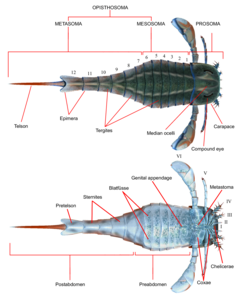
![サソリの構造 各項説明:[注釈 1]](http://upload.wikimedia.org/wikipedia/commons/thumb/2/2f/Scorpion_Tagged_%28PSF%29.png/339px-Scorpion_Tagged_%28PSF%29.png)
